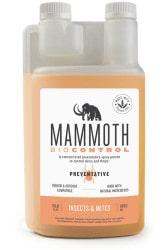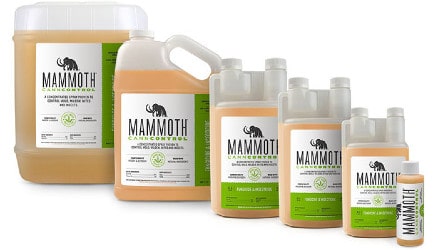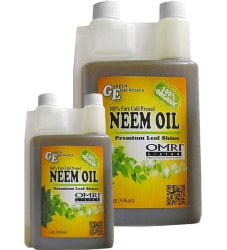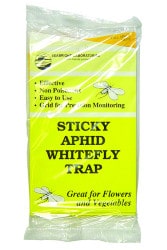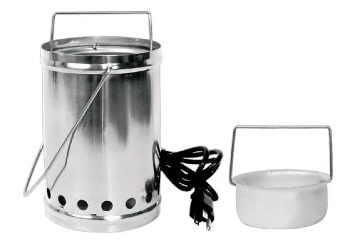10Buds Grow Guide
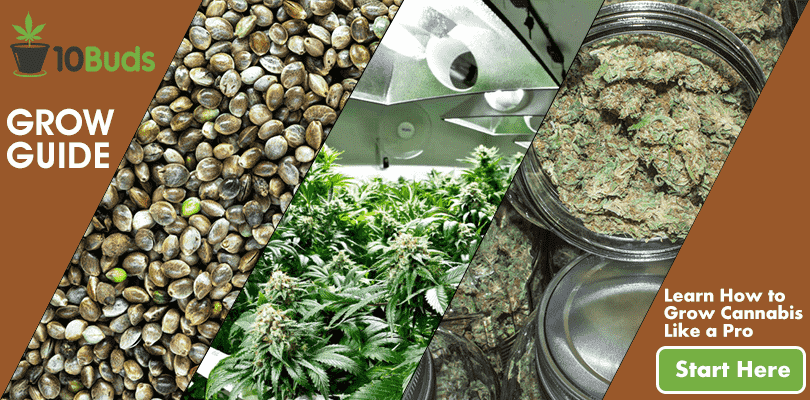 Whether it’s your first time growing weed or you’re a cultivation expert, 10Buds provides the most up-to-date information on how to grow cannabis.
Whether it’s your first time growing weed or you’re a cultivation expert, 10Buds provides the most up-to-date information on how to grow cannabis.
Never waste a cent again by choosing the perfect cannabis strain from the best online seed bank with our in-depth reviews. Whether you grow cannabis indoors or outdoors, we’ve curated grow guides that are a cut above the rest and tailored to growers of every skill level.
Allow us to guide you through the process of growing weed, such as germination, vegetation, flowering, and, ultimately, harvesting and curing top-shelf cannabis flowers. From start to finish, our step-by-step grow guides cover everything from A-Z to ensure a trichome-packed harvest.
When you’re ready to take your cannabis garden to the next level, our cannabis grow guides are the ultimate source.
Step 0: Cannabis 101
If you’ve never grown weed before — this section is for you. Step 0 is the basics of growing cannabis and answers all of the necessary questions before you begin to grow your own weed.
If it’s not your first time growing weed and you feel confident with the basics, head over to Step 1.
Growing Marijuana is Cheap
One of the best reasons to grow your own cannabis is because it can be as cheap as you want it to be.
Where some growers spend hundreds of thousands of dollars setting up a state-of-the-art grow facility — you can harness the power of the sun, a garden hose, and dirt straight from your backyard.
Whether you grow marijuana indoors or outdoors, there's always tips and tricks to keep the bill down and the yield way up.
Growing Weed is Easy
Easy is a relative word; however, cannabis is called weed for a reason.
That's right; cannabis is a prolific grower that's typically tough to kill and extremely beginner-friendly. As with anything, you'll come across a difficult strain to grow at some point, but never-the-less, marijuana is one of the easiest plants to grow and well worth your time.
You Can Control The Quality When Growing Your Own Weed
Unless you grow your own cannabis, you can never trust the quality of another grower.
Cannabis plants are grown worldwide and are traded multiple times until they reach you — the consumer. From pesticides to poor agricultural practices, you'll never know how the plant was grown or what was put on it.
One of the best reasons to grow your own weed is because you can control the quality. The final product is everything you want it to be — from organic soil to meticulously trimmed buds that you want to smoke.
Growing Cannabis is Fun!
There's nothing more fun than coming home to inspect your ladies.
After a long day, you'll be hard-pressed to feel frustrated while gazing at a room (or closet) full of beautiful cannabis plants. Since you're new, every aspect of growing marijuana will be filled with wonder and excitement.
Growing weed is a hands-on experience that forces you to feel the plants, smell the flowers, and indulge in the final product. Believe us when we say that growing weed will change your life forever.
Ditch the Dispensary or Dealer
Buying weed is outrageously expensive. If you're tired of paying upwards of $20 per gram for WhoKnows OG, it's high time to learn how to grow your own marijuana.
Once you learn how to grow weed, each gram can be as cheap as $1. That's right — growing weed significantly drops the price — so you can pocket the cash and smoke the best homegrown on the block.
You Can Make Money From Growing Weed
Another primary reason why you should grow marijuana is that you can make money.
Whether you decide to make growing cannabis your profession eventually or you want to smoke for free — making a bit of cash from your harvest is a tried-and-true option.
From selling marijuana to a local dispensary or to a fellow medical marijuana patient, growing weed is truly a green experience.
The Cost of Growing Marijuana Indoors
Growing marijuana indoors is typically more expensive than growing outdoors.
Growing cannabis indoors allows you to grow top-shelf buds in a controlled environment. However, the high-quality flowers of growing cannabis indoors come at a cost. From grow equipment to electricity bills, growing marijuana indoors may cost between $500 to $5,000 and up.
The overall cost of growing your own marijuana depends on the grow equipment purchased, the number of plants, and the required energy.
The Cost of Growing Marijuana Outdoors
Growing weed in the great outdoors has some serious perks, such as free electricity, soil, and beneficial microorganisms.
However, outdoor growers must contend with mother nature's mood swings, such as environmental fluctuations, pests, and disease. Whether you're on a budget or want to grow cannabis au natural — growing weed outdoors is much cheaper than growing marijuana indoors.
Overall, expect to pay $200 to $2,000+ on your outdoor cannabis garden.
Potential Yield From Growing Cannabis Indoors
Every cannabis grower's indoor garden will vary in size. As you will learn, the size of the garden dictates the size of the plant.
There are two ways to measure the yield per plant. The first way is by calculating meters squared, such as nine cannabis plants within a square meter. In this case, 450-550-grams of marijuana is the average yield.
The second method is to yield per plant. However, yields vary depending on plant size. Overall, expect single plants to yield between 200-450-grams.
Potential Yield From Growing Weed Outdoors
Growing outdoors allows you to produce monster yields.
Typically, outdoor plants are enormous because they have an abundance of space to grow. Depending on the cannabis strain, outdoor growers can expect to yield between 450-1,000-grams per plant.
Marijuana plants are living things.
As such, they require basic elements to grow and produce a healthy crop of frosty flowers. The recipe for happy weed plants is basic, and it consists of water, nutrients, light, temperature, and air — among other things.
Nutrients
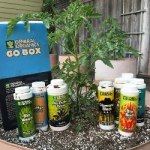
All cannabis plants require nutrients.
Nutrients are chemical elements that cannabis plants need to perform necessary functions to complete their life cycle. From leaf color to flower growth, nutrients are a critical component that you must incorporate into your cannabis garden.
Water

Like all living things, cannabis plants require an abundance of water.
Regarding cannabis plants, water is the necessary element that transports nutrients and sugar throughout the plant. Furthermore, water assists with photosynthesis and maintains the plant’s overall structure.
Light

There are two primary reasons why cannabis plants need light.
The first is for the necessary function of photosynthesis. Photosynthesis is the act of converting light energy into chemical energy to power the cannabis plant's activities.
Furthermore, cannabis plants are photoperiodic, which means weed plants react to the amount of light received. This physiological reaction enables marijuana plants to grow or flower continuously.
Temperature

Marijuana plants typically require a pleasant temperature range, such as 72-84°F. However, some cannabis strains may flourish in warmer or colder conditions.
The reason why cannabis plants need an ideal temperature range is to protect itself from the negative consequences of drought or frost.
Humidity
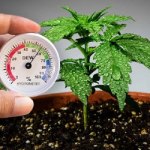
Cannabis plants require a humidity range of 40-45%.
The reason why marijuana plants need this humidity range is because they must evaporate excess water through the leaves (transpire). As the water vapor exits via the leaves, the cannabis plant can continue to draw nutrients from the soil or hydroponic system.
Medium

All cannabis plants require a medium to anchor the root system.
A medium can be anything that cannabis roots interact with, such as organic soil, water in a hydroponic system, rockwool cubes, or coco coir. Overall, the medium is responsible for supplying roots with air, nutrients, and water.
Air Circulation
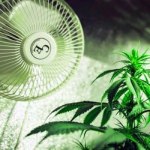
Marijuana plants require air circulation for two primary functions.
First, constant airflow across the cannabis plant makes it stronger. Next, when you grow multiple cannabis plants close to each other, the overall humidity level rises. Air circulation reduces the concentration of humidity and decreases the chance of pests, diseases, fungal, and bacterial outbreaks.
CO2

Marijuana plants require carbon dioxide because it assists with photosynthesis. CO2 and water are the two elements needed to convert light energy into energy (sugar).
CO2 is naturally found everywhere; however, you may have less if you grow marijuana indoors without fresh air access.
One of the most essential aspects of growing weed is understanding the anatomy of cannabis plants.
Learning how to determine males from females and different portions of the cannabis plant is crucial to a successful harvest.
Cannabis Seeds
Cannabis seeds vary in size, from 2-7mm in length. Furthermore, cannabis seeds exhibit various markings depending on the strain.
As you look at a cannabis seed, you'll notice a round end and a pointed end. All cannabis seeds contain a radicle and a set of cotyledons to begin its life.
Cannabis Seedlings
Once the cannabis seed germinates, the radicle digs into the medium, and the cotyledons grow toward the light. At this stage, you now have a cannabis seedling.
The cannabis seedling consists of two cotyledons that contain 1-2-weeks worth of nutrients. The cotyledons are not real leaves; however, after 3-5-days, true leaves will emerge from the stem.
Juvenile Cannabis Plants
2-3-weeks after germination occurs, the cannabis plant is classified as a juvenile.
The juvenile cannabis plant consists of 2-3 nodes, an elongated stem, and multiple fan leaves that contain 3-5 leaflets. Furthermore, the root zone continues to expand during this stage.
Male Cannabis Plants
First and foremost, male cannabis plants do not produce weed. Instead, male cannabis plants produce pollen, which is the enemy of all cannabis cultivators who want to grow THC-packed weed.
Typically, male cannabis plants produce stocky stems and squat growth. Overall, only cannabis breeders grow males in order to create seeds.
By the 4th week of growth (6-8-weeks after germination), the male cannabis plant will exhibit pre-flowers along the 4th to the 6th node. The pre-flowers grow from the axillary bud (staminate primordia) and produce small pre-pollen sacs.
Female Cannabis Plants
Female cannabis plants are responsible for producing weed. As a cannabis cultivator, the overall goal is to find and flower female cannabis plants.
By the 4th-week of growth (6-8-weeks after germination), the female cannabis plant exhibits pre-flowers along the 4th to the 6th node. The pre-flowers grow from the axillary bud (pistillate primordia) and produce a small round sac that emits 1-2 pistils.
As long as the female cannabis plant is kept away from males (and their pollen), it continues to produce pistils, calyxes, and bracts in search of pollen.
Male Cannabis Flowers
Once a male cannabis plant reaches sexual maturity and the flowering stage, it will emit an inflorescence of male flowers. Once again, male flowers do not produce weed.
The male inflorescence consists of numerous flowers along a branch. Each node contains 2-4 flowers, and as the flowers open, the male stamens are exposed. The male stamens contain pollen sacs that release millions of grains of pollen.
Female Cannabis Flowers
Once a female cannabis plant reaches sexual maturity and the flowering stage, it will begin to flower.
The female flower consists of an ovule, bract, and a pair of pistils. As the female cannabis plant flowers, hundreds of calyxes form along each node. The calyx is the protective layer that surrounds the bract and ovule.
If the pistil receives pollen, the pollen travels down the pollen tube and fertilizes the ovule. It is within the ovule that the cannabis seed forms.
However, if the female plant does not receive pollen, it will continue to flower and produce more pistils, bracts, and calyxes. After 7-10-weeks (or more), the female flower is ready for harvest.
Feminized Cannabis Seeds
If your goal is to grow weed easily, you must grow only female marijuana plants. Feminized seeds are made to produce only female cannabis plants through in-depth breeding methods.
Due to this unique feature, it’s recommended that beginners use feminized cannabis seeds. Not only will feminized seeds save you a lot of time, but they also prevent unruly cannabis males from ruining your garden.
Nearly all cannabis strains come in feminized form and flower within 7-12-weeks. Therefore, you can rest assured that you’ll find a wide variety of feminized indica, sativa, and hybrid seeds for your indoor cannabis garden.
Autoflowering Cannabis Seeds
Autoflowering cannabis seeds contain Ruderalis genetics, which is a type of species of cannabis that does not rely on the changing seasons, such as from summer to fall, to produce flowers.
Instead, autoflowering cannabis seeds rely on an internal clock that speeds up the entire growing process. As such, autoflowering strains do not grow tall and are ideally suited for those with limited space.
Additionally, autoflowering strains are typically feminized. Therefore, autoflowering seeds are by far the most beginner-oriented seeds available.
Autoflower cannabis seeds are the cruise control option for cannabis cultivators. Whether it’s your first time growing weed or you don’t have the time, autoflowering cannabis strains are the perfect solution for the indoor marijuana garden.
Autoflowering seeds can be indica, sativa, or hybrids and flower within 7-12-weeks after germination.
Regular Cannabis Seeds

Regular cannabis seeds produce male and female marijuana plants, which makes them difficult to grow. Therefore, regular cannabis seeds are not recommended for beginners.
Regular marijuana seeds are suited for professional cannabis cultivators or those with a lot of experience. Overall, regular cannabis seeds require more space, time, money, and effort to grow compared to feminized or autoflowering cannabis seeds.
Regular seeds can be indica, sativa, or hybrids and flower within 7-12-weeks depending on the strain.
Germination Stage
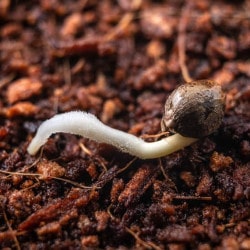
The first step in the cannabis life cycle begins with the germination stage.
Once you add water onto the feminized cannabis seed, several chemical reactions occur throughout 24-48-hours. During this critical phase, the root and shoot emerge from the seed.
Seedling Stage
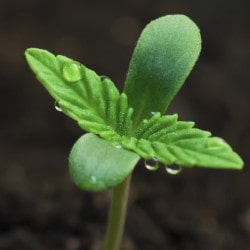
Once you've successfully germinated your cannabis seed, the radicle forms the root system, and the shoot produces two cotyledons.
The seedling stage is an incredibly vulnerable time and lasts anywhere from 1-2-weeks.
Juvenile Stage
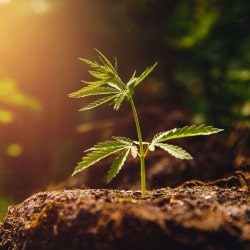
The juvenile stage is the phase where a cannabis plant finds its legs.
In other words, the juvenile stage encourages root expansion, stem elongation, node formation, and leaf growth. It's during the juvenile stage that your cannabis plant will begin to look like a marijuana plant.
Overall, the juvenile stage lasts between 1-2-weeks.
Vegetative Stage
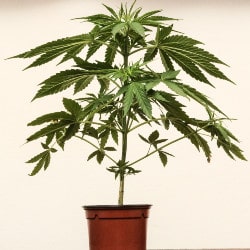
For feminized strains, the vegetative stage lasts for 2-12-weeks. Outdoors, feminized strains may vegetate between the months of April to July until flowering begins in August. Indoors, however, growers may allow the strains to veg for 1-4-weeks.
The vegetative stage requires increased nutrition and water as the plant becomes larger and larger. Overall, a cannabis plant in the vegetative stage will produce extensive roots, branches, nodes, and leaves.
Most importantly, the cannabis plant that is well into the vegetative phase is sexually mature, which means it exhibits pre-flowers to identify males and females. Even if you buy feminized marijuana seeds — you must always check to ensure the sex is female.
Lastly, the vegetative phase is characterized by an abundance of light, such as the 18/4 or 24/0 light schedule indoors or the long daylight summer hours in outdoor gardens.
Pre-Flowering Stage
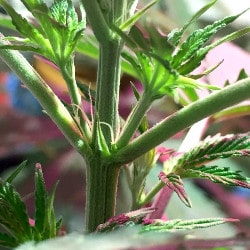
The pre-flowering stage occurs once the light schedule is set to 12/12 indoors or when fall begins outdoors.
The decrease in light signals to the cannabis plant that it's time to begin the flowering stage. However, the pre-flowering stage encourages last-minute growth and can double or triple a plant's size within 2-weeks.
It's during the pre-flowering stage that the sex of the cannabis plant is apparent. It’s at this stage that you must check your feminized strain is, in fact, female.
Flowering Stage
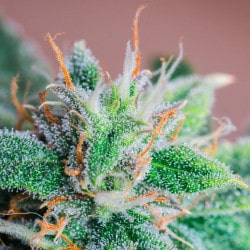
The flowering stage occurs 2-weeks after the pre-flowering stage.
During the flowering stage, the female flowers will swell in size due to the production of calyxes, bracts, and pistils, and THC-packed trichomes. In general, the flowering stage lasts between 7-10-weeks from the beginning of the pre-flowering stage.
Harvest

Once the flowers are ripe — it's time to harvest. This is the final stage of the cannabis life cycle that results in the cannabis plant’s death.
If you're learning how to grow marijuana, this is one of the last and most essential steps until you get to indulge in your own homegrown bud.
*We’d like to thank CNBS.org for their invaluable content contribution to 10Buds.
Germination Stage
Autoflower seeds germinate the same as feminized cannabis seeds.
Seedling Stage
Autoflowering seedlings are grown similarly to feminized seedlings.
Vegetative Stage
Autoflowering cannabis plants grow quickly and do not stay in the vegetative stage as long as feminized strains.
Autoflowering marijuana strains typically stay in the vegetative stage for 2-4-weeks. Once the strain reaches maturity, an internal clock will force the autoflowering strain to the next phase.
Flowering Stage
The flowering stage of autoflowering plants lasts between 6-8-weeks, depending on the strain. It’s at this stage that the autoflowering strain produces THC or CBD-packed flowers.
Harvest
Similar to feminized strains, harvest time begins once the cannabis flowers ripen. This is the final stage of the autoflowering strain’s life cycle.
Indica Flowering Stage
It's important to note that feminized indica seeds flower in a shorter time-frame than sativa seeds.
The primary reason why indica strains have a shorter flowering window is their genetic origin in regions that experience short summers. Therefore, indicas flower quickly, such as 7-9-weeks, and are ideal for cultivators who need a quick harvest.
Sativa Flowering Stage
It's important to note that feminized sativa seeds flower in a longer time-frame than indica seeds.
The longer flowering time for sativas is due to their genetic origin in tropical or subtropical zones that exhibit long summers. In other words, sativas take longer to flower, such as 9-12-weeks. However, the additional time typically leads to a large yield.
Cannabinoids, also known as phytocannabinoids, are naturally-occurring chemical substances found within trichomes of the cannabis plant.
There are over 100 identified cannabinoids; however, we’ll discuss the most notable examples below.
THC

Tetrahydrocannabinol, also known as THC, is the most common and abundant cannabinoid found in cannabis flowers.
THC is a psychoactive cannabinoid, producing a “high” or “stoned” effect. Ultimately, THC is sought after for its recreational and medicinal properties.
THCA

Tetrahydrocannabinol-acid, also known as THCA, is the inactive (precursor) form of THC and is abundant in fresh cannabis.
THCA is a non-psychoactive cannabinoid that provides substantial relief against seizures, migraines, and inflammation. Once heated to 230F and above — THCA converts to THC in a process known as decarboxylation.
THCV

Tetrahydrocannabivarin, also known as THCV, is a relatively minor cannabinoid that does not produce psychoactive effects.
Instead, THCV is known to promote appetite loss, reduce anxiety, elevate mood, and reduce the effects of neurological diseases. THCV is typically found in THCV-rich hemp strains.
CBD

Cannabidiol, also known as CBD, is the second most important cannabinoid found in cannabis plants.
CBD is found in large concentrations in hemp strains. Although CBD can be found in THC-rich cannabis strains — the level of available cannabidiol is typically much lower than those found in hemp cultivars.
CBD is notable for its medicinal and non-psychoactive effects. CBD is known to relieve and deter a wide variety of mental and physical issues.
CBDA

Cannabidiolic Acid, also known as CBDA, is the precursor to CBD.
As such, CBDA is a non-psychoactive cannabinoid that’s found in hemp and cannabis strains. Once temperatures reach 230F and above, CBDA decarboxylates into CBD.
Ultimately, CBDA is believed to be much more effective than CBD. The primary method to consume CBDA is via raw extracts, such as tinctures, capsules, juiced hemp flowers.
CBG

Cannabigerol, also known as CBG, is a non-psychoactive cannabinoid that’s found in small concentrations in both hemp and cannabis plants.
Due to the scarcity of CBG — CBG-rich products are challenging to find and expensive. However, CBG is extremely effective at reducing inflammation, glaucoma, and neurological disorders. Furthermore, CBG offers antibacterial properties and even cancer-fighting effects.
CBN

Cannabinol, also known as CBN, is a cannabinoid that forms once THC breaks down.
Once THC ages, the THC molecules break down into the CBN molecule. Overall, CBN is mildly psychoactive while promoting relaxing effects that stimulate the sleep cycle.
Ultimately, CBN is present once THC-rich cannabis flowers have undergone intensive oxidation and degradation.
CBC

Cannabichromene, also known as CBC, is a non-psychoactive cannabinoid known for its pain-killing ability.
Although found in small quantities, CBC is a potent cannabinoid used for its anti-inflammatory effects. Furthermore, CBC promotes neurogenesis in patients prone to neurological disorders.
CBC-rich products are only found in extract form due to their scarcity in cannabis flowers.
What is the Entourage Effect?
The entourage effect is the term that describes the holistic function of multiple cannabinoids interacting with the body’s endocannabinoid system.
The overall idea behind the entourage effect is that each cannabinoid acts synergistically with another to promote profound effects throughout the human body.
The only way to experience the entourage effect is by consuming cannabis products that are not stripped of cannabinoids during the production process.
Step 1: Choosing to Grow Cannabis Indoors or Outdoors
Growing cannabis indoors and outdoors both offer advantages and disadvantages.
There are a multitude of aspects to consider when choosing to grow cannabis indoors or outdoors. Let’s look at the pros and cons of growing weed in indoor and outdoor environments.
| Indoors | Outdoors | |
|---|---|---|
| Costs | − Expensive start-up and maintenance costs | + Extremely affordable |
| Skill | − More technical than growing weed outdoors (Requires more care and maintenance) | + The easiest method to grow marijuana |
| Weather | + Complete control of the environment − Requires ventilation and air filtration |
− No control over environmental conditions |
| Growing Season | + Grow cannabis year-round | − Seasonal. One crop per season (unless using autoflowering strains) |
| Yield | + Large Yield | + Large Yield (Final yield heavily dependent on local climate) |
| Discretion | + Discrete | − Not discrete |
| Light | − Requires electricity setup | + Free sunlight |
| Threats | + Lower prevalence of pests | − High prevalence of pests, fungi, bacteria, and disease |
When growing cannabis indoors — you control everything.
Indoor cannabis gardens are an entirely different beast when compared to growing weed outdoors. From the technical know-how to start-up costs, growing weed indoors is a labor-intensive endeavor.
However, your efforts will not be in vain when growing marijuana indoors. If you're after High Times quality buds, there's no better option than growing weed indoors.
Let's look at everything you need to know about growing marijuana indoors for the first time.
The Potential Cost and Yield of Growing Cannabis Indoors
The first questions that come to mind are how much does it cost to grow weed and how much weed can I yield indoors?
The answer to this question is — it depends.
Here’s a brief example of the potential cost of growing one marijuana plant vs. ten:
- One cannabis plant grown indoors: $1,000
- Ten cannabis plants grown indoors: $2,500
Now, let’s take the same examples and look at the potential yield of one cannabis plant vs. ten:
- The yield of one marijuana plant grown indoors: 450-grams
- The yield of ten marijuana plants grown indoors: 4,500-grams
In the above example, the price-per-gram of growing a single cannabis plant indoors is $2.22. On the other hand, the price-per-gram of growing ten cannabis plants indoors is $0.55.
The overall lesson is that the more weed you grow, the cheaper the cost per gram. Therefore, it’s always a bright idea to raise more than one feminized or autoflowering seed when growing weed indoors.
However, you can head over to the How to Grow Weed Indoors article to overview the total value for money and effort, where we cover topics on cost, yield, the golden ratio, and calculating the price-per-gram when growing weed indoors.
Equipment Needed For Growing Weed Indoors
The indoor cannabis garden will not function correctly without essential pieces of equipment, such as:
- Grow lights
- Grow Tent (or build your own grow room)
- Grow Medium
- Nutrients
- Nutrient and pH Meters
- Ventilation
- Pest and disease control
- Irrigation equipment
As you'll learn, buying the best equipment for growing marijuana indoors is necessary to ensure a bountiful harvest of resin-coated buds.
If you want to learn about all of the required pieces of equipment for growing marijuana indoors, jump to our How to Grow Weed Indoors article and read the section on the equipment needed for growing weed indoors.
*If you already know which tools you need, head over to Step 2 to choose the best equipment for your indoor weed garden.
How to Plan an Indoor Cannabis Garden
Building a solid foundation is necessary for all aspects of life. Therefore, planning your indoor cannabis garden is no different.
Read our How to Grow Weed Indoors article and head over to the section titled How to Plan an Indoor Cannabis Garden to learn everything you need to know to get your marijuana garden up and running.
By following each step, you will adequately prepare your garden for each stage of the growing process.
The Pros and Cons of Growing Marijuana Indoors
Now that you understand everything there is to know about growing weed indoors, let's sum everything up with the pros and cons of growing cannabis indoors.
Pros of Growing Weed Indoors
- Top-shelf flowers
- Increased yield potential
- Complete control of the environment
- Year-round growing
- Discrete
- Less prevalence of pests and disease
Cons of Growing Weed Indoors
- Expensive start-up costs
- Electricity bills
- More technical than growing weed outdoors
- Requires ventilation and air filtration
- Requires more TLC than growing weed outdoors
There's nothing quite like growing weed in the great outdoors.
Cannabis plants show their true potential outside, and it makes sense — the outdoors is their natural environment. Let's take a look at everything you need to consider when choosing to grow marijuana outdoors.
The Potential Cost & Yield of Growing Marijuana Outdoors
The first thought that comes to mind when choosing to grow marijuana outdoors is the potential cost and yield.
Growing marijuana outdoors is by far the most affordable method when compared to indoor cannabis cultivation. Furthermore, the yields of outdoor-grown weed typically eclipse that of cannabis grown indoors.
Let's look at two different examples to understand the potential cost and yield of growing one plant versus ten plants outdoors.
- One cannabis plant grown outdoors: $300
- Ten cannabis plants grown outdoors: $2,000
Now, here’s the breakdown of potential yield from the same example:
- The yield of one marijuana plant: 500-grams
- The yield of ten marijuana plant: 5,000-grams
In the above example, the price-per-gram of a single outdoor-grown cannabis plant costs $0.60. The price-per-gram of ten outdoor marijuana plants is $0.40.
The underlying lesson here is that the more weed you grow — the cheaper the cost per gram. Therefore, you should always grow more than one feminized or autoflowering plant if you can.
Head over to our How to Grow Weed Outdoors article and read the section titled The total value for money and effort for a complete breakdown on cost, yield, and the price-per-gram when growing weed outdoors.
Equipment Needed For Growing Weed Outdoors
Cannabis plants require air, light, water, and a place to anchor their roots, and all of this can be readily found in your backyard.
Here's a list of essential tools when growing weed outdoors:
- Germination supplies
- Grow medium
- Irrigation supplies
- Amendments
- Pots
- Pest and disease control
- Greenhouse (not mandatory)
- Accessories
If you’re unsure which tools you require, dig deeper and read our How to Grow Weed Outdoors article and dive into the section titled equipment needed to grow weed outdoors.
*If you already know what your outdoor garden needs, skip to Step 2 and choose the best equipment for your outdoor garden.
How To Plan an Outdoor Cannabis Garden
Now that you're ready to get your cannabis garden off the ground — it's time to make a comprehensive plan and turn your dream into a reality.
Allow our guide, How to Grow Weed Outdoors, to walk you through a step-by-step process of planning an outdoor marijuana garden. By following each step, your outdoor weed garden will be prepared for the growing season ahead.
The Pros and Cons of Growing Weed Outdoors
Now that we've covered everything you need to know about growing weed outdoors, here's a TL;DR of the pros and cons of growing marijuana in the great outdoors.
Pros of growing weed outdoors:
- Growing cannabis outdoors is easy
- Affordable
- Reduced carbon footprint
- Less attention required compared to indoor gardens
- Large plants produce massive yields
- Less equipment needed than indoor gardens
- Multiple harvests per growing season (autoflowering strains)
- No artificial lighting required
Cons of growing weed outdoors:
- Outdoor plants are dependent on the elements or seasons
- Not practical if you live in a densely populated city
- Thieves, pests, and diseases are more prevalent in outdoor gardens
- One crop per year (unless you grow autoflowering seeds)
- Decreased flower quality
Step 2: Buy Growing Equipment
Whether you choose to grow cannabis indoors or outdoors — you must acquire various tools to push your cannabis crop to the limit.
From high-powered lighting to trimming scissors and everything in between, here’s a list of must-have equipment to help your cannabis garden thrive.
Grow lights are the cornerstone of all indoor cannabis gardens.
Without light, cannabis plants wouldn’t be able to grow indoors. Therefore, grow lights are one of the essential pieces of cannabis growing equipment in your arsenal.
However, not all grow lights are created equal. Before you pull the trigger on the first grow light you come across, you must first educate yourself on the topic of grow lights.
Let’s begin.
What are Grow Lights?
Grow lights are specialized lights intended for horticultural or agricultural use.
When growing cannabis indoors, cultivators need to mimic the natural environment of the great outdoors. Although nothing is as powerful as the sun, grow lights are built to provide all the necessary elements a plant needs via light, such as:
- Light spectrum
- PAR
- Lumens
Grow lights are primarily suited towards indoor cannabis gardens. However, they can also be used as supplemental lighting in greenhouse cannabis gardens. Overall, grow lights are an incredible tool to grow feminized and autoflowering cannabis seeds year-round.
The Different Types of Grow Lights
Unlike cannabis growers in the early 90s, we're blessed with a multitude of cannabis grow lights that make a world of difference in terms of plant health and yield.
Furthermore, buying cannabis grow lights is as easy as a click of a button — literally. Let's look at the different styles of cannabis grow lights to help you get your indoor cannabis grow on track.
1. HID Grow Lights
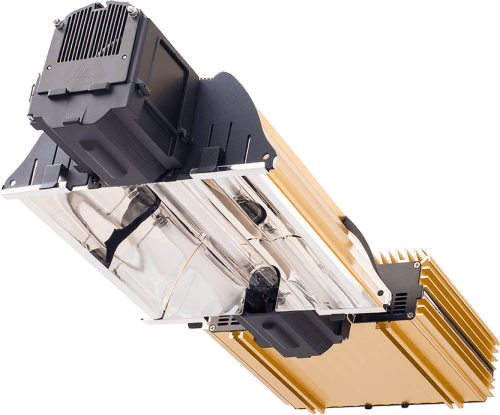
HID (high-intensity discharge) lighting is by far the most popular type of indoor lighting.
If you asked us a decade ago which grow light was the best, we would have said HIDs — hands down. However, the times are changing, and HIDs are no longer at the top of the heap. Although they produce massive amounts of light, they are not as efficient as other lighting types, hence the sky-high electricity bill.
HID lights do, however, provide new growers with an affordable option when building their first indoor grow room. Furthermore, HID lights come in a wide array of wattages, such as
- 300w
- 600w
- 1,000w
What Type of HID Grow Light Systems are Available?
Depending on your garden and budget, there are two aspects that you must choose when using a HID grow light system:
- MH (metal halide) vs HPS (high-pressure sodium) lamps
- Magnetic vs. digital ballasts
The Pros and Cons of HID-style grow lights:
- Produce intense light
- Generate massive harvests
- Increase trichome production
- Easy to use
- Affordable
- Great for multiple cannabis plants
- Large light footprint
- Expensive electricity bill
- Overheating danger
- Heavy ballast
- Generate high heat
- Requires other tools to cool them down
Best Use Case For HID Grow Lights
Lastly, let's look at the best use case for HID grow light systems.
- Vegetative Stage
- Flowering Stage
2. LED Grow Lights
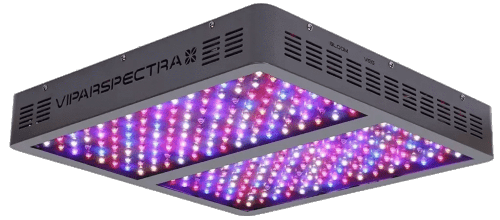
Initially, LED grow lights were not taken seriously by the cannabis cultivation community. Now, however, the tables have turned. Unlike traditional HID grow lights, LEDs utilize light-emitting diodes.
LEDs are increasingly popular among beginners and professionals alike. From high light output to lower electricity bills and heat output, LEDs are an excellent option for your indoor cannabis garden.
Typically, you’ll find LED grow lights with a wide array of wattages, such as:
- 100w
- 250w
- 300w
- 600w
- 1,000w
The Pros and Cons of Growing Cannabis Indoors with LED Grow Lights.
- Efficient
- Emits low heat
- Long lifespan
- Full-spectrum lighting
- Low electricity bill
- Very versatile
- Large light footprint
- Expensive upfront cost
- Not as powerful as HID or plasma lighting
- Risk of light bleaching
Best Use Case For LED Grow Lights
Now, let's look at the use cases for LED grow lights.
- Germination stage
- Juvenile stage
- Vegetative stage
- Flowering stage
Read More about LED Grow Lights:
The Best LED Grow Lights for Cannabis Cultivators - Main Category Page
The Best Full Spectrum LED Grow Lights
The Best Quantum Boards
The Best 1000 Watt LED Grow Lights
Spider Farmer LED Grow Lights
Spider Farmer SF-4000 LED Grow Light Review
Mars Hydro LED Grow Lights
3. Plasma Grow Lights
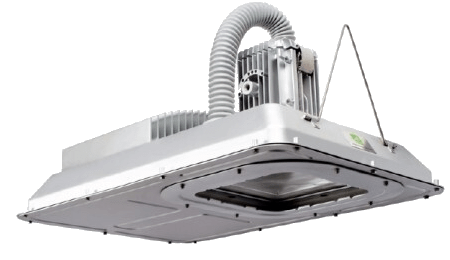
Plasma grow lights are at the forefront of indoor lighting technology.
Plasma lights fuse the sheer power of HID bulbs while utilizing the efficiency of LEDs. In other words, plasma lighting offers the best of both worlds in a streamlined grow light package.
The Pros and Cons of Plasma Grow Lights:
- High efficiency
- Massive light output
- Decreased heat emission
- Full-spectrum lighting
- Lower electricity bill than HIDs
- Large light footprint
- Expensive upfront cost
- Too powerful for small grow rooms
Best Use Case For Plasma Grow Lights
Let's look at the best stages to use plasma lighting in the indoor garden.
- Juvenile stage
- Vegetative stage
- Flowering stage
4. Fluorescent Grow Lights
Another suitable option for indoor cannabis growers is fluorescent lighting.
Fluorescent bulbs offer new cannabis growers a happy medium of low wattage and decent light output. Although fluorescent lighting isn't nearly as powerful as a plasma or HID, it allows growers to move the lights closer to the cannabis canopy.
Two common types of fluorescent lighting are popular among marijuana cultivators:
- T-5 grow lights
- CFL grow lights
T-5 Grow Lights
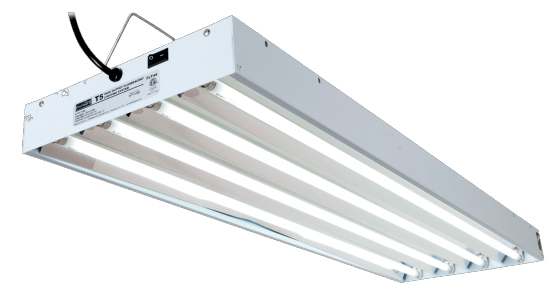
T-5 grow lights are elongated and are typically between 12-60 inches in length. The number of T-5 bulbs depends on the manufacturer. However, you will find T-5 systems that contain 2-8 bulbs per unit.
The Pros and Cons of T-5 Grow Lights:
- Powerful light output
- Efficient
- Easy to find
- Bulbs are cheap to replace
- Easy to use
- Can be placed near the canopy
- Low electricity bill
- May not fit in small grow rooms
- Multiple units needed to cover a large area
- Relatively expensive
- Not as powerful as traditional HID or Plasma
Best Use Case For T-5 Grow Lights
- Seed germination stage
- Juvenile stage
- Vegetative stage
CFL Grow Lights
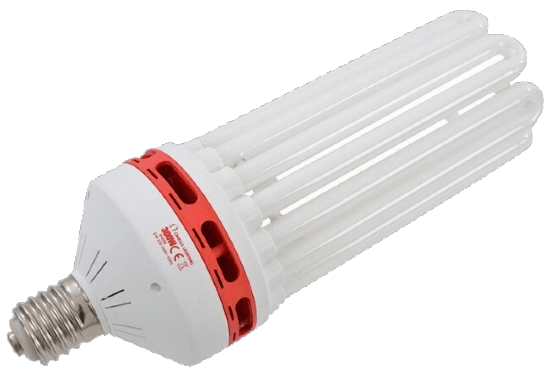
CFLs, on the other hand, are compact fluorescent lights. CFLs are the small bulbs that must be replaced when they burn out, such as your living room lamp or nightstand lamp. As it so happens, these same bulbs can be used to grow cannabis indoors.
The Pros and Cons of CFL Grow Lights:
- Does not require a ballast
- Easy to use
- Very affordable
- Can be placed near the canopy
- Produces negligible heat
- Low electricity bill
- Weak light output
- Ineffective for multiple plants
Best Use Case For CFL Grow Lights
- Germination stage
- Juvenile stage
Which Grow Light Should I Use?
This is a tricky question that many new cannabis growers get hung up on.
Should you choose the 1,000-watt electricity guzzling HID or the eco-friendly 600-watt LED for your new grow tent? How about a high-output T-5 over the 300-watt HPS for your single plant closet grow?
Before you make a decision, here are the criteria you must consider to find your best option.
- The size of the grow room
- The total number of feminized or autoflowering plants
- The ability to cool the grow room down
Let’s quickly sum up each consideration:
The Size of the Grow Room:

First, the size of the grow room dictates the type of grow light. If you’re growing in a small closet, it’s best to choose an energy-efficient light that doesn’t produce much heat, such as LEDs or CFLs. Alternatively, a larger room may benefit from more light, which is accomplished with the help of a HID, plasma, or high-watt LED.
The Total Number of Feminized or Autoflowering Plants:

Next, knowing how many feminized or autoflowering plants will go in the garden helps you determine how much light your grow room requires. You may buy a grow light that produces too much or too little light without understanding this concept.
A single autoflowering cannabis plant does not need a 1,000-watt HID. Instead, a low-watt LED or T-5 system will suffice. As you can see, the more plants, the more light required to satisfy your cannabis crop.
The Ability to Cool the Grow Room Down:

Lastly, can you quickly reduce the temperature in your grow room or grow tent? If you’re only willing to answer one of the three considerations we’ve previously mentioned in this grow guide — make sure it’s this.
For example, a cannabis garden located in the attic can benefit from various grow lights — depending on the ventilation scenario. If you can vent hot air out of the grow room, you can harness any grow light of your choice. If you can’t vent excess heat from the grow room, you must choose a grow light that emits low heat, such as a CFL, LED, or T-5.
How Do I Hang Grow Lights?
One of the most common questions we receive from beginners is how to hang grow lights. Although we’ll dive deeper into this subject with a step-by-step guide, let’s cover the basics of hanging grow lights.
If growing weed in a grow tent, you can easily hang grow lights with chains or rope-ratchets. If you build your own grow room, you may need to drill anchor points in the ceiling to hang your grow lights.
There are two primary types of hangers for grow lights:
- Adjustable hangers
- Jack chain
Without going into too much detail, adjustable hangers allow you to quickly raise or lower your grow lights as your feminized or autoflowering plants grow. Alternatively, jack chains are more difficult to adjust.
Read: How to Hang Cannabis Grow Lights
Grow Lights and Fire Safety

One of our chief considerations when creating this grow guide for beginners is our readers’ safety. Although safety is often overlooked, we believe it’s a primary consideration that every new cannabis grower needs to understand before learning how to grow weed.
Whether you’re new to growing weed or have a few grows under your belt, let’s put on our serious face for a moment and consider grow lights and fire safety.
Remember, grow lights require power, which means electricity. Faulty or improperly setup grow light systems are the primary cause of indoor grow room fires. As such, you must ensure that the grow light you choose is certified for safety.
Here’s a list of safety certifications to look out for:
- UL listed
- CE marketing
- ETL certification
- FCC certification
There are other considerations to mitigate the possibility of a fire, such as circuit breakers, which we’ll expand upon later in our cannabis grow guide series.
With so much power under the hood of modern-day grow lights, it’s better to be safe than sorry when choosing the best grow light for your indoor garden.
The grow tent is one of the essential pieces of equipment for your indoor cannabis garden.
Thousands of cannabis cultivators worldwide rely on grow tents to provide a dedicated space for marijuana plants. Furthermore, grow tents are meant to work with other equipment pieces, such as grow lights, ventilation, and much more.
If this is your first time growing weed, it's time to read this grow guide to discover grow tents.
What are Grow Tents?
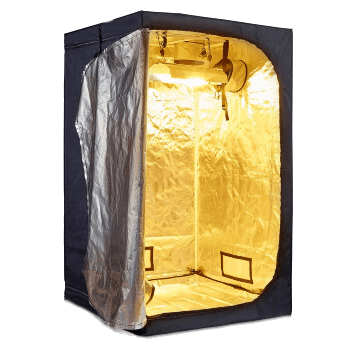
Grow tents are enclosed gardens that allow cultivators to create a perfect environment for cannabis plants — indoors.
Modern-day grow tents are made from durable canvas, such as heavyweight Cordura. The foundation of the grow tent consists of PVC poles, which create the skeleton. Once the PVC poles are erected, the canvas is stretched across to form the overall structure.
At their very core, grow tents provide growers of all skill levels with a grow room that only takes a few minutes to build. Ultimately, grow tents make it easier to grow weed at home.
Now that you understand what a grow tent is let's look at the different available types and how to choose the best grow tent.
The Pros and Cons of Grow Tents
If you jumped into this section to quickly find out if grow tents are right for you, here’s a list of the pros and cons of grow tents:
- Affordable
- Easy to build
- An excellent choice for beginners
- Easier to control pests and diseases
- Energy efficient
- Limited grow space
- Reduced accessibility
- Difficult to customize
What are the Different Sizes of Grow Tents?
Grow tents come in all shapes and sizes, which allows you to pick the best tent for your needs. Whether you want to grow cannabis in a closet or your bedroom — you'll find a grow tent with the perfect fit.
Here's a list of the most common grow tent sizes:
- 2x2x6'11"
- 2x4x6'11"
- 4x4x6'11"
- 4x8x6'11"
- 8x8x6'11"

As mentioned, this is not an exhaustive list of available grow tent sizes, but instead, the most common and popular. The primary reason why each of these sizes is popular among indoor cannabis growers is that they offer the perfect size for non-professional cultivators.
Most beginners that are learning how to grow marijuana indoors do not need a 10x10x6'11" grow tent. Instead, most new cannabis gardeners find a happy medium between the 4x8' and the 2x2'.
Although we'll outline the specific criteria to look for when choosing a grow tent, here's a pro tip — always pick a grow tent you can grow with. In other words, choose a grow tent that's big enough to let you expand your garden as you find your inner green-thumb.
What is the Cost of a Grow Tent?
Grow tents range from $100 to $2,500.
Of course, the cost depends on a range of factors, such as
- Size
- Features
- Materials
As always, you must choose a grow tent according to your budget. However, you must seek a grow tent that offers the best bang for your buck. We'll discuss more about choosing a grow tent below in this guide.
Benefits of Growing Weed in a Grow Tent
Now, let's look at the benefits of growing weed in a grow tent.
Easy to Set Up
One of the best aspects of growing weed in a grow tent is their ease of use.
We would never recommend something for beginners if it weren’t easy to use. Grow tents are so easy to set up that nearly anyone can do it.
Overall, grow tents consist of a canvas covering and a PVC structure. The steps to assemble a grow tent are minimal and can be completed with your eyes closed. Ok, maybe not with your eyes closed, but you get the point.
Quickly Reduce Heat
Another reason why you want to grow weed in a grow tent is because of its enclosed space.
Thanks to the sealed environment, you can utilize inline fans to remove excess heat generated from the grow lights. Removing excess heat provides a comfortable ambient temperature for your grow room, which means happy plants.
Affordable
Grow tents are surprisingly affordable.
We understand that affordable is a relative term, but the vast majority of grow tents cost below $500. When compared to building your own grow space, an instant grow room is well worth the money.
Convenient
When you're new to growing weed, the last thing you need is complications.
Building your own grow space requires quite a bit of carpentry skills, so it's always more convenient to use a grow tent. Grow tents are easy to set up, and they allow you to get your garden up and running within a moment's notice.
Discrete
Grow lights pump out an impressive amount of light — especially HIDs and plasma systems. Unless you want to signal to everyone in town that you're growing weed, grow tents keep the light contained.
Additionally, grow tents are surprisingly discrete in their appearance. A small grow tent may not warrant the attention of guests at your home.
Protection
Grow tents offer protection for your indoor cannabis crop in multiple ways.
First, grow tents are light proof, ensuring light from outside the tent does not leak inside. Remember, cannabis plants are sensitive to light cycles, and it's dangerous to subject flowering cannabis plants to light during dark periods.
Next, grow tents protect cannabis plants from a myriad of harmful aspects inside the home. For example, indoor cannabis crops can be destroyed by an overly excited dog. Furthermore, dust, pollen, and even fungal spores are kept at bay by the grow tent’s sturdy material.
Optimized Environment
The most significant benefit of grow tents is their ability to produce an optimized environment.
Grow tents are built with cannabis growers in mind; therefore, it's ready to contain inline fans, grow lights, filters, and much more.
As you piece together the equipment to outfit your grow tent, you’ll soon be ready for lift off. You’ll be amazed by the quality and quantity of weed that’s achievable with a fine-tuned grow tent.
How to Choose the Best Grow Tent
Now, let's briefly look at what you need to look for when choosing a grow tent.
Remember, you don't need the latest and greatest grow tent to grow excellent weed. Instead, you need a proven design that's ready to handle your new-found cannabis endeavor.
Size

First and foremost is the size of the grow tent.
When deciding on the size, you need to ask yourself — where will this grow tent be in the first place?
Once decided, measure the area and find a grow tent that exhibits slightly fewer dimensions to ensure the right fit.
Number of Cannabis Plants

Next, how many cannabis plants do you intend to grow?
Remember, the number and size of cannabis plants will rely on the size of the grow tent. Therefore, you must consider the size and number of plants in conjunction with the grow tent’s overall size.
Lightproof
There are thousands of grow tent brands, but not all are created equal.
Therefore, you must find a grow tent that is light proof. Grow tents must keep grow light contained in the grow room and outside light out.
Remember, a lightproof grow tent provides discretion and prevents hermaphrodites.
Durable
Always ask yourself — should I buy once or twice?
By choosing a durable grow tent, you will likely grow cannabis in it for years on end. However, if you buy a cheap grow tent, you may need to buy another soon after as it begins to fall apart after one or two grow cycles.
Inner Mylar
When you learn how to grow marijuana indoors, you should always be concerned about the amount of light your plants receive.
If you cannot provide any more light to your cannabis crop via increased wattage, worry not — there's another grower's tip to help you out.
Mylar is a highly reflective material that'll increase the brightness in the grow room. Make sure you choose a grow tent with durable mylar walls to increase the light in the garden.
Features
Furthermore, you should always look for a grow tent that provides several features.
Here's a list of features that no budding-cannabis grower should forego:
- Multiple cinching ducting ports
- Multiple doors/entrances
- Viewing window
- Multiple cinching electrical ports
- Thick canvas density
- Spill tray
- Adjustable roof
- Ultra-strong support poles
Remember, the grow tent is a stand-alone cannabis garden. Everything will be inside, from grow lights to fans, and the grow tent should be equipped to handle everything.
Versatile
It's essential to choose a cannabis grow tent that's versatile.
The reason we emphasize versatility is that grow tents will provide several roles during its tenure. Here's a list of possibilities that you grow tent can provide:
- Act as a germination room for your feminized or autoflowering cannabis seeds
- Act as a breeding room
- Act as a vegetation room
- Act as a flowering room
- Act as a drying and curing room
As you can see, the possibilities are endless with a high-quality grow tent.
Ease of Use
Last but not least is to consider the ease of use of a grow tent.
The mantra, keep it simple, stupid (KISS), rings loud and clear when choosing a grow tent for your upcoming indoor cannabis garden.
Always choose a grow tent that offers easy access, along with an adequate number of ports. As long as all of your growing equipment fits comfortably inside, you'll have a stress-free growing experience.
Read More About Grow Tents:
The Best Grow Tents for Cannabis Cultivators - Main Category Page
The Best Grow Tent Kits
The Best 4x4 Grow Tents
The Best 2x2 Grow Tents
The Best Vivosun Grow Tents
Let's talk about grow media.
Whether you grow indoors, outdoors, or in outer space, all plants must be grown in grow media. As you glide through this guide, you'll find everything you need to know about the different media types and which are the best for budding cannabis cultivators such as yourself.
What is Grow Medium?
When you hear cannabis cultivators talk about grow mediums, they are merely speaking about the material they grow their cannabis plants in.
If I told you that I grew my cannabis plants in organic soil, organic soil is the grow medium. If I instead tell you that I'm using rockwool cubes, then rockwool cubes are the grow media.
The term grow media is lingo from traditional horticulture and agriculture. It has, however, caught on among weed growers. As you'll soon find out in this guide, there are three primary categories of grow mediums, which are further broken into smaller sub-groups.
What is The Function of Grow Media?
Grow media presents a platform where cannabis roots:
- Derive nutrients, air, and water
- Provide an anchor point to support the plant
- Allow for root expansion
As you can see, grow media is essential for your indoor or outdoor cannabis plant to thrive. If your cannabis crop has no means of retrieving nutrients, air, or water — it will rapidly die. The same will happen if the roots have nowhere to go or if the plant cannot hold itself upright.
Therefore, learning about grow media is one of the first steps to growing cannabis at home.
What Are the Different Types of Grow Mediums?
Next, let's look at the different types of grow mediums.
To make this easy to digest, we're breaking this section into three parts — hydroponic, soil, and hybrid-based media. We'll briefly describe the sub-groups found in each type. As you learn about each, you'll soon realize which may best suit your needs and growing style.
Hydroponics
There's a misconception among beginners that hydroponics means growing cannabis in water. Although there is truth to this, hydroponics simply describes growing plants in something other than soil. With this in mind, hydroponic grow mediums are also known as soilless mediums.
The glaring differences between hydroponic and soil are that soilless mediums are chemically inert and require bottled nutrients to feed the plants.
Here's a list of hydroponic-based mediums that are popular among cannabis cultivators:
Water

Water is a primary medium that's used for hydroponic cultivation. Whether the water is inside a bucket or a tray, water provides roots with air, nutrients, and, of course — water.
Rockwool
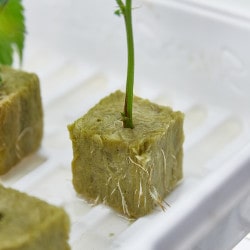
Rockwool is made from mineral wool and is one of the most interesting soilless growing mediums around. Rockwool efficiently retains moisture and allows cultivators to grow large plants in small rockwool blocks.
Clay Pellets
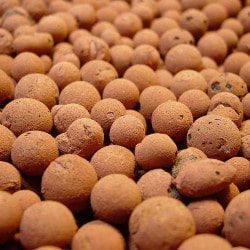
Clay pellets, also known as expanded clay, is another excellent hydroponic-based medium. Not only are clay pellets reusable, but they retain moisture and provide exceptional aeration to the root zone.
Perlite
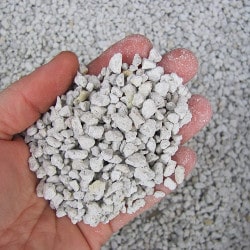
Perlite is a volcanic glass that's been expanded through intense heat. Perlite is incredibly porous; however, it does not have any water retention capabilities.
Coco Coir
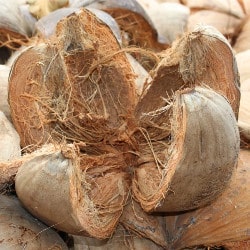
Coco coir, also known as coco, is the inner fiber found in coconuts. Coco coir efficiently retains moisture, provides aeration, and is reusable.
Soil

Now, when you hear cannabis cultivators talk about soil, they are talking about a combination of minerals, organic matter, beneficial organisms, water, air, and the remains of decaying organisms.
Suddenly, dirt doesn't sound so dull, does it?
Aside from this massive ingredient list, soil is chemically reactive. However, we will not discuss the chemically reactive nature of soil in this guide.
To sum soil up, here are three different types of soil that you can use to grow marijuana at home:
- Store-bought soil
- Soil from your backyard
- Soil amendments, such as worm castings and bat guano.
As a final point, soil provides the food necessary for cannabis plants to thrive. In other words, say goodbye to expensive bottled nutrients.
Hybrid
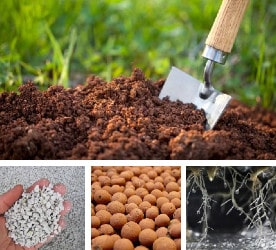
Last but not least is hybrid-based mediums. Hybrid mediums are exciting because they bridge the gap between hydroponics and soil. In other words, hybrid-based media provides increased aeration, high water retention, and greater control when feeding marijuana plants.
Common hybrid combinations are:
- Soil and perlite
- Soil, sphagnum peat moss, and perlite
- Soil, coco coir, and perlite
We could go on and on because the combinations are endless. However, the examples mentioned above are commonly used for cannabis cultivation among professionals and beginners alike.
Lastly, hybrid-based grow mediums are popular among cannabis cultivators because you can create your own blend. By buying bags of soil and soilless grow media, you can experiment with a variety of ratios to build the perfect grow medium for your indoor or outdoor marijuana garden.
The Cost of Grow Media
Now that you have an idea of the different types of grow media let’s look at the general cost of each.
The number of cannabis plants and the size of the containers ultimately dictates the amount of media required. Here are a few examples to give you an idea of the cost of grow media when cultivating a single feminized cannabis plant.
- 5 cubic foot bag of organic soil: $35
- One 6” rockwool cube: $5
- 5 cubic foot bag of hybrid grow media: $30
As you can see, it’s more expensive to grow a single cannabis plant in soil or a hybrid-based medium. However, the cost of growing in soil and hybrid-based mediums decreases as you grow more feminized and autoflowering seeds.
Which Grow Media is Suitable for New Cannabis Growers?
If you're new to growing weed — you want the most straightforward media to pull off your first harvest.
The most suitable medium for growers in our Beginner's 101 class is none other than soil.
Some of you may ask, "why soil? Shouldn't I grow in rockwool like all the pros on YouTube?"
Unlike hydroponics, soil offers natural buffers within the media that absorb the multitude of mistakes that beginners encounter during their pot-growing debut. Furthermore, soil does not require expensive pH and EC meters.
However, this is not to say that you shouldn't dip your toes in soilless-based mediums for your first grow. Soilless growing media, such as coco-coir and rockwool, is suitable for beginners, but they require an additional learning curve and expensive tools to monitor pH and nutrient levels.
The Pros and Cons of Hydroponic, Soil, and Hybrid-Based Grow Media
Whether you stuck with us through this guide or skipped to the TL;DR section — here's the summed up pros and cons of each type of media.
| Pros | Cons | |
|---|---|---|
| Hydro | - Promotes ultra-fast growth - Provides the largest yield - Customizable nutrient regimen - You are in total control - Easy to flush - Easy to transport (light) - Reusable (some) | - Requires expensive tools - Requires technical know-how - Small mistakes lead to significant consequences - Not all hydroponic-based media is reusable - Requires continuous moisture |
| Soil | - Absorbs beginner's mistakes - Natural & organic - Produces large yields - Doesn't require expensive tools - Doesn't require in-depth know-how - Reusable - Efficiently retains moisture | - Difficult to flush if you provide too much nutrient - Difficult to transport (heavy) - Difficult to customize |
| Hybrid | - Generates significant yields - Promotes vigorous plants - Customizable - Easy to flush - Retains moisture | - Requires expensive monitoring tools - Requires technical know-how - Doesn't absorb beginner's mistakes |
By now, you almost have everything you need to grow weed at home.
The next ingredient you need for a successful marijuana garden is nutrients. However, what are nutrients, and why are they so crucial for cannabis cultivation? From your plant's overall health to bud production, nutrients are about to become your new best friend.
In this guide, we'll discuss everything you need to know about growing cannabis with nutrients.
What are Nutrients?
In a nutshell, nutrients for growing weed are pre-made products that contain the essential micro and macro-nutrients that a cannabis plant needs to thrive.
Each nutrient has a role to play, such as:
- Build thick stems
- Maintain green leaves
- Increase resin production
- Stack the flower's weight
- And much more
As you can see, nutrients are a vital piece of the puzzle as you learn how to grow weed.
Remember, the term nutrients are broad. Since you want to use nutrients to grow cannabis — you must make sure you buy the correct product.
Let's continue to the next section of this guide to teach you about the nitty-gritty aspects of nutrients for growing weed.
What Are The Different Types of Nutrients Used For Growing Weed?
Now, let's look at the different types of nutrients for growing cannabis.
1. Nutrients For Hydroponic-Based Media

When it comes to growing weed in hydroponics or soilless-based media, you'll need to use bottled nutrients. Bottled nutrients are concentrated nutrients that contain all of the necessary nutrients at precise ratios.
Bottled nutrients must be mixed with water and monitored with a pH meter and an EC, TDS, or PPM meter before feeding it to your cannabis plants.
2. Nutrients For Soil-Based Media

Next up are nutrients for soil-based media.
Although organic soil already has an abundance of nutrient content, you may want to amend the soil with additional additives for an added boost. In this case, you can use:
- Bottled nutrients (soil-specific brands)
- Soil amendments (bat guano, worm castings, bone meal, blood meal, and so forth).
3. Nutrients For Hybrid-Based Media
If you are growing weed in a hybrid-based medium, you can use both soil or soilless-specific nutrients. However, it's best to choose a nutrient that fits your medium's dominant profile.
In other words, if you have a hybrid medium that contains 75% coco coir and 25% soil, it's best to use hydro-specific bottled nutrients.
Therefore, the options are:
- Bottled nutrients (soil or soilless-specific brands)
- Soil amendments (bat guano, worm castings, bone meal, kelp meal, etc.)
Cannabis-Specific Nutrients and Ratios
When it comes to nutrients and plants — the proof is in the ratio.
In other words, all plants have a preferred ratio of various nutrients. Whereas cannabis plants prefer an abundance of phosphorus during the flowering stage, different species of plants might not.
Now, you may ask, “what happens if I don’t give my cannabis plants the right nutrients?”
That’s a great question, so here’s a list of potential problems that may occur if you provide the wrong nutrients.
- Reduced yield
- Stunted growth
- Burned leaves
- Yellow leaves
- Purple stems
- Reduced pest and disease resistance
The list goes on and on. Therefore, you must provide the right nutrients with proper ratios. It’s because of these potential issues that we recommended that you use cannabis-specific nutrients when growing weed.
Now, you must be wondering — which nutrients do cannabis plants like and at what ratio?
Let's take a look.
Macro-Nutrients For Growing Weed
Here's a list of the essential macronutrients that all cannabis plants need. Although macro-nutrients are commonly regarded as N-P-K, there are a few others that you must recognize.
- Nitrogen (N)
- Phosphorus (P)
- Potassium (K)
- Calcium (Ca)
- Sulfur (S)
- Magnesium (Mg)
Micro-Nutrients For Growing Weed
Next, here's the list of essential micro-nutrients — also known as trace minerals. However, don't be fooled by the term micro. Each of these nutrients is just as essential as macronutrients and are necessary for your cannabis plant's overall health.
- Iron (Fe)
- Boron (B)
- Chlorine (Cl)
- Manganese (Mn)
- Zinc (Zn)
- Copper (Cu)
- Molybdenum (Mo)
- Nickel (Ni)
Nutrient Ratios For Growing Weed
As we mentioned previously, cannabis plants prefer nutrients in specific ratios. Don't worry — this isn't your introduction to chemistry class, and you're not being graded. Instead, you can use the information in this guide to buy the best cannabis nutrients and push your cannabis crop to the limit.
The Best Grow Nutrient Ratio For Cannabis Plants in the Vegetative Stage
The vegetative phase is primarily responsible for plant growth, which means leaf production, stem elongation, and root growth. It's no wonder why nutrient products meant for leafy growth are known as grow nutrients.
Cannabis responds the best to a nitrogen-dominant ratio during the vegetative phase. Remember, nitrogen is the primary component of green growth.
Here are two examples of acceptable grow nutrient ratios for the vegetative stage for cannabis plants.
- A bottled grow nutrient that offers an N-P-K of 7-5-5
- A soil amendment that provides an N-P-K of 1-0.2-2
The Best Bloom Nutrient Ratio For Flowering Cannabis Plants
Next, let's learn about bloom nutrients.
Bloom nutrients are another way to describe nutrient products that should be used during the flowering stage. Research shows that more phosphorus and potassium during the flowering stage equals larger buds.
Here are two examples of acceptable bloom nutrient ratios for cannabis plants in the flowering stage.
- A bottled bloom nutrient that offers an N-P-K ratio of 1-5-4
- A soil amendment that provides an N-P-K of 4-6-4
Which Nutrient is Best For Beginners?
The answer to this question depends on your grow medium.
For hydroponics - we recommend bottled cannabis nutrient kits that include grow, bloom, and micronutrient bottles.
By choosing a cannabis nutrient brand that offers separate grow and bloom mixes, you can be reassured that your plants will receive the necessary nutrient ratios during each stage of growth.
If you choose to grow cannabis plants in soil - it's best to utilize soil amendments. The reason why soil amendments are better than bottled nutrients for soil-based media is that they do not require a pH or PPM meter.
Find more information about cannabis nutrients in our complete guide on Cannabis Nutrients and Organic Cannabis Nutrients.
The Learning Curve of Bottled Nutrients and Cannabis
Before you start pouring liquid nutrients onto your cannabis plants, you must first understand the bottled nutrients’ learning curve.
Unlike soil amendments, bottled nutrients are immediately absorbed by plant roots and drastically change the medium’s pH. Although rapid absorption is ideal when correcting a nutrient deficiency, too much nutrient can instantly burn your plants.
Let's look at the various factors you must understand before you begin using bottle cannabis nutrients.
- Mixing Nutrients with Water
- Measuring the pH of the Nutrient Solution
- Measuring the EC/PPM/TDS of the Nutrient Solution
The Cost of Cannabis-Specific Nutrients
As you browse nutrient brands online, you'll find a wide variety of prices.
Here are a few examples of what you can expect when buying cannabis-specific nutrients to grow weed.
- A bottled nutrient kit that includes both grow, bloom, and micro: $40 for three 1-quart bottles
- All-purpose soil amendment: $20 for five pounds
Overall, bottled nutrients are more cost-effective because they are concentrated. Therefore, a single bottled cannabis nutrient kit may last multiple harvests — depending on the number of feminized or autoflowering seeds that you grow.
The Pros and Cons of Cannabis Nutrients
Finally, let's take a look at the pros and cons of bottled and dry (soil amendments) nutrients.
The Pros and Cons of Bottled Cannabis Nutrients
- Control and customize the nutrient profile
- Nutrients are immediately available to the root zone
- Bottled nutrients can last a long time
- Possible to find organic bottled nutrients
- Require expensive pH and EC/TDS/PPM tools
- Increased learning curve
- Not beginner-friendly
- Easy to overfeed and "burn" plants
- Unless organic, bottled nutrients are not eco-friendly
The Pros and Cons of Soil Amendments
- Eco-friendly and organic
- Does not require pH or EC/TDS/PPM meters
- Beginner-friendly
- Provides a natural buffer for beginner's mistakes
- Can be recycled for subsequent grow
- Interact with beneficial bacteria and fungi
- Takes longer to fix deficiencies
- Not easy to customize and control
- More expensive than bottled nutrients
- Attracts pests
- Unless dialed in, soil amendments produce a lower yield
Read More About Cannabis Nutrients:
The Best Cannabis Nutrients & How to Use Them - Main Category Page
The Best Organic Cannabis Nutrients
*If you decide to grow cannabis in hydro or soilless-based media — this section is a must-read.
Nutrient and pH meters are the backbone of growing weed in hydro. Growing cannabis without a nutrient or pH meter is akin to driving while blind. As you can imagine, you won't get far if you skimp out on a nutrient or pH meter.
Whether this is your first time growing weed or not, pH and nutrient meters demand your complete attention. Once you breeze through this guide, you'll have a much better understanding of the necessity of owning a nutrient and pH meter when growing marijuana in hydroponics.
What is a Nutrient Meter?
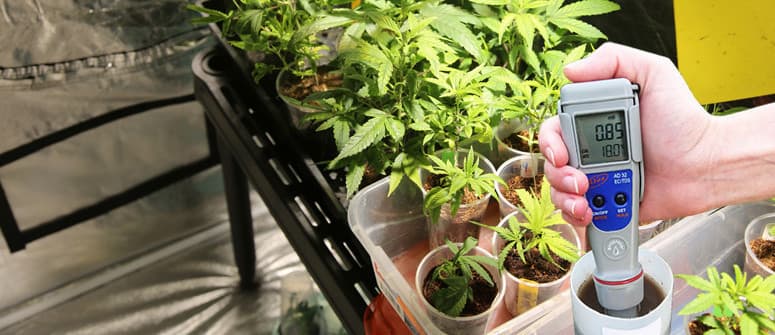
The most basic definition of a nutrient meter is a tool that monitors the nutrient content in a given solution.
You must be asking — but what does a nutrient meter do, and why do I need one?
Well, let's first glance back at what bottled cannabis nutrients are. Bottled cannabis nutrients are composed of mineral salts and are considered inorganic compounds. As the salt dissolves in water, you're left with a solution.
Now, nutrient meters monitor the salt content (nutrient content) within the solution. As the nutrient meter relays this information to you, you get to decide if it's too much or too little for your cannabis plants.
By using a nutrient meter, you'll always know the amount of nutrients going into your plants. Without one, however, each feeding is pure guesswork. If you provide bottled nutrients to your plants without a nutrient meter, you will do more harm than good.
Therefore, a nutrient meter allows you to:
- Provide accurate doses of nutrient
- Customize nutrient profiles
- Troubleshoot nutrient deficiencies and toxicities
What Are The Different Types of Nutrient Meters?
There are two types of nutrient meters that cannabis cultivators, such as yourself, rely on.
Let's look at each type so you can familiarize yourself before you buy one.
EC Meter
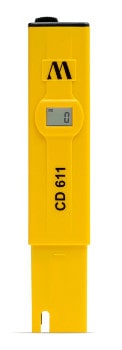
EC meters, also known as electrical conductivity meters, are handheld tools that measure the electrical conductivity in a solution.
EC meters:
- Measure in mS/cm or millisiemens per centimeter
- Measure the amount of inorganic dissolved content
- Measure electrical conductivity between salt and water
- Are the popular choice in Europe; however, they are increasingly popular in the United States and Canada
TDS Meter
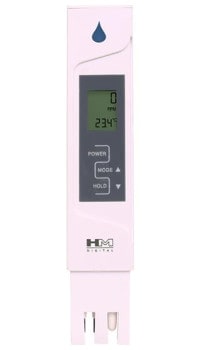
TDS meters, also known as total dissolved salt meters, are similar to EC meters. However, the primary difference between EC and TDS meters is:
- TDS meters measure both inorganic and organic dissolved content
- TDS meters measure in PPM (parts-per-million)
- The popular choice in the United States
Which Nutrient Meter is Best For Beginners?
Both TDS and EC meters present a similar learning curve, such as the initial calibration process.
Therefore, the better question is — which nutrient meter is more accurate? Although both are accurate, EC meters are typically viewed as the most reliable.
The primary reason why EC meters are recommended over TDS is simply that EC only measures dissolved inorganic content. When you mix a nutrient solution, you want to calculate how much nutrient is in the water. Although TDS meters will provide a similar result, their readings may be influenced by other factors within the water that is not salt-based.
How Much Do Nutrient Meters Cost?
The price tag of a nutrient meter depends on its features and accuracy.
Here's a list of examples to help you gain a better idea of how much a nutrient meter costs:
- EC/TDS electronic inline meter: upwards of $600
- Handheld TDS meter: $35
- Handheld EC meter: $40
As you can see, handheld monitors are very affordable. However, the all-in-one electronic inline meter offers stunning features, such as rapid calibration, Bluetooth functionality, and pinpoint accuracy.
Since you're new to cannabis cultivation, we recommend purchasing a basic handheld meter.
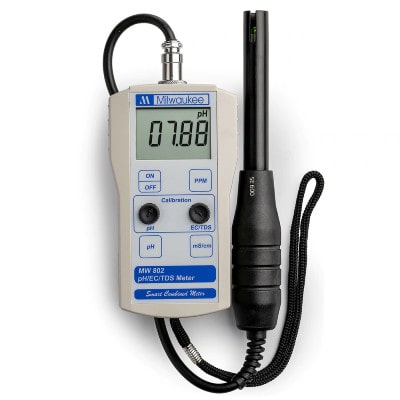
The Pros and Cons of TDS and EC Meters
Lastly, let's touch upon the pros and cons of TDS and EC meters.
The Pros and Cons of TDS Meters
- Provides accurate readings to feed cannabis plants
- Affordable (depending on type)
- Allows you to troubleshoot your cannabis plants
- Simple to use after calibration
- Not as accurate as EC meters
- Expensive (depending on type)
- Requires initial calibration
- Requires routine maintenance
The Pros and Cons of EC Meters
- The most accurate type of nutrient meter
- Affordable (depending on type)
- Provides accurate readings to feed cannabis plants
- Allows you to troubleshoot your cannabis plants
- Simple to use after calibration
- Expensive (depending on type)
- Requires initial calibration
- Requires routine maintenance
What is a pH Meter?
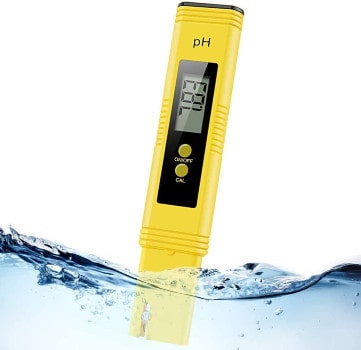
Next up is pH Meters.
If you decide to grow in soilless or hydroponics — you must have a pH meter. You cannot, I repeat, you cannot cultivate cannabis in hydro without a pH meter — it's that important.
As for the definition, a pH meter is a tool that measures the power of hydrogen (pH) from 0-14 to determine the alkalinity or acidity of a water-based solution.
If the hydrogen-ion activity is high, the water-based solution is deemed alkaline. If the hydrogen-ion activity is low, the water-based solution is acidic. If the hydrogen-ion activity is in the middle, the solution is neutral.
Here are the ranges of pH that you must become familiar with:
- Alkaline: 8-14 pH
- Neutral: 7 pH
- Acidic: 1-6 pH
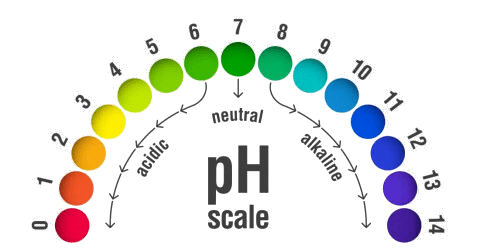
Why is pH Important?
Now, the golden question — why is pH important?
The answer is because all plants, especially cannabis, require nutrients to be in specific pH zones to become available to the roots.
Here are the preferred pH ranges of soil and hydro-based mediums that cannabis requires:
- Soil: 6.2-6.7 pH
- Hydro: 5.2-5.7 pH
If you do not feed your cannabis plants the proper pH zone, the following issues will occur:
- Nutrient lockout (can't absorb nutrients)
- Stunts root growth
- Produces nutrient toxicity
As you can see — your cannabis plant's health depends on a proper pH'd nutrient solution.
What Are The Different Types of pH Meters?
When it comes to pH meters, there are three primary types. Let's take a brief look at each and check their overall differences.
pH Pen

pH pens are standard among new and professional growers.
pH pens are handheld pH meters that you can quickly dip into the nutrient solution for an accurate reading. However, you must first calibrate the pH pen to ensure its readings are on-point. Lastly, pH pens are electronic, and you can easily view the pH on the screen.
pH Test Kit
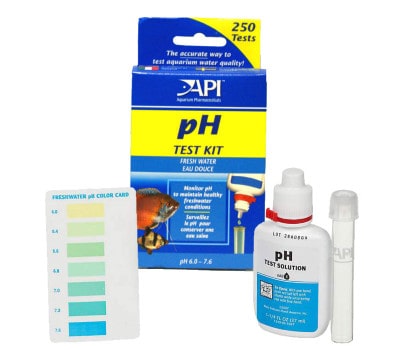
pH test kits are elementary in functionality. Although they will provide a pH reading, it is a ballpark figure.
The way pH test kits work is by using a litmus paper and dipping it into the nutrient solution. As the color of the paper changes, you must match it with the kit's indicator. However, the accuracy is nothing like a pH pen or pH monitor.
pH Monitor
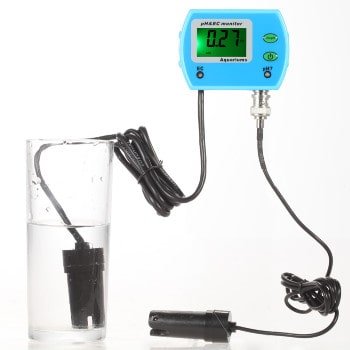
pH monitors are expensive, but incredibly accurate, meters.
pH monitors are fastened to the wall, and the probe is always submerged in pH 7 solution. If you can stomach the bill, pH monitors offer some of the most exciting features, such as Bluetooth connectivity, alarm settings, and 24/7 monitoring.
Which pH Meter is Best For Beginners?
Whether it's your first time growing weed or not, the best pH meter to start with is a pH pen.
Unlike pH test kits and expensive pH monitors, pH pens allow you to pH nutrient solution quickly, affordably, and most importantly, with confidence.
What Do I Need to Calibrate my pH Pen?
Whether you opt for the pH pen or pH monitor, you must calibrate the pH meter.
You will need a few accessories to calibrate your pH meter, such as:
- pH 4.01 calibration solution
- pH 1.0 calibration solution
- pH 7 calibration solution
Using the three-point calibration method, you can rest assured that your pH meter is providing pinpoint readings.
The Pros and Cons of pH Meters
Finally, it's the part you've all been waiting for — the TL;DR section. Let's look at the pros and cons of each type of pH meter.
The Pros and Cons of pH Pens
- Easy to use
- Affordable
- Low maintenance
- Accurate pH readings
- Must be calibrated before each use
The Pros and Cons of pH Test Kits
- Very affordable
- Low maintenance
- Easy to use
- Not as accurate as pH pens or monitors
- More hands-on than pH pens or monitors
The Pros and Cons of pH Monitors
- Extremely accurate
- Do not need to recalibrate before each use manually
- Offers many beneficial features
- Expensive
- May not be suitable for beginners
- Learning curve
As your indoor grow room begins to take shape, it's time to consider one of the most important aspects of growing weed indoors — ventilation.
Unlike the great outdoors, cannabis plants don't have unlimited air access when confined in indoor gardens. This section will help you understand the basics regarding ventilation, various ventilation products, and how to determine which type of ventilation product is right for you.
As you'll soon find out in this guide, ventilation can make or break your indoor growing experience. Whether it's your first time growing weed or not, let's jump in and discover the basics of ventilation.
What is Ventilation?
Ventilation is the exchange of outdoor air into an indoor area or vice versa.
There are two primary types of ventilation:
- Mechanical (fans)
- Natural (wind)
In terms of the indoor cannabis grow room, the air is pumped from outside and dumped into the grow space using mechanical ventilation. Therefore, we will only cover mechanical ventilation in this section.
Why is Ventilation Important?
Cannabis, like all plants, requires fresh air exchange for optimal growth. Without fresh air and air exchange through ventilation, your cannabis crop may be doomed.
Overall, ventilation is essential because:
- Air exchange (CO2)
- Reduces humidity
- Removes excessive heat from the grow room
- Reduces potential for pest, disease, bacterial, and fungal outbreaks
- Increases the strength of branches and stems
Who Needs Ventilation?
Although it may seem obvious, let's look at who needs ventilation.
First and foremost are those who cultivate cannabis indoors. However, it's not just indoor growers — outdoor growers in greenhouses need them too.
Although you can grow weed indoors without fans (proper ventilation equipment), we do not recommend it.
What is CFM?
Before diving into the different ventilation types (fans), let's discuss all ventilation-related products’ rating system — CFM.
CFM, or cubic feet per minute, is the amount of air that a fan can move per minute. Cannabis cultivators must decide how much air must be moved per minute in the grow room to achieve optimal air circulation.
Overall, you'll find a wide selection of CFM ratings as you browse fans for your indoor grow room, such as:
- 165 CFM
- 400 CFM
- 720 CFM
- 970 CFM
The Different Types of Ventilation
Now, let's look at the different ventilation equipment types that you can use to outfit your grow room with fresh air 24/7.
1. Inline Fans
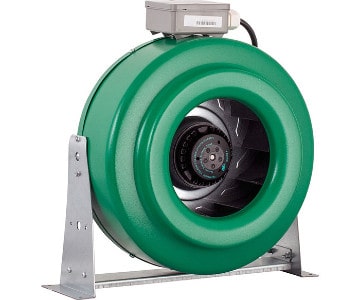
When it comes to ventilation, the number one choice for indoor growers is inline fans.
Inline fans come in various sizes and fan speeds. Overall, inline fans are incredibly efficient at pulling air in and blowing air out. Typically, an indoor grow room will use two inline fans in the following setup:
- One inline fan for intake
- One inline fan for the outtake
In most cases, inline fans that are tasked with outtake are connected to HIDs via ducting. By joining the inline fan, ducting, and HID hood, you can effectively remove a significant heat level.
2. Oscillating Fans
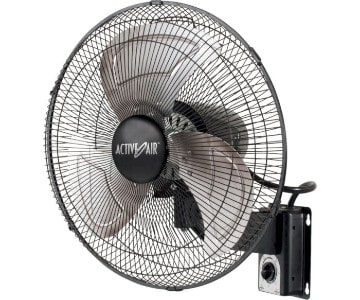
Next up are oscillating fans.
Oscillating fans are fantastic for the grow room because they oscillate and blow air across the plant canopy. Unlike inline fans, oscillating fans cannot bring air in or blow air out of the grow space.
The basis for utilizing one or more oscillating fans in the grow room is to:
- Reduce humidity
- Promote leaf movement to decrease the chance of fungal, bacterial, or pest outbreak
- Strengthen branches and stems
3. Clip-On Fans
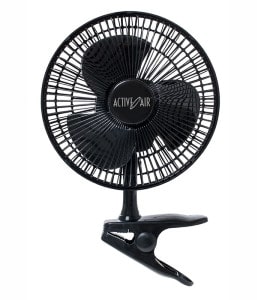
The clip-on fan is the little brother of oscillating fans.
Unlike oscillating fans, clip-on fans do not oscillate. Instead, clip-on fans exhibit a fixed position and consume less power.
Clip-on fans are ideal for:
- Small spaces (closet)
- Tight spaces
4. Booster Fans
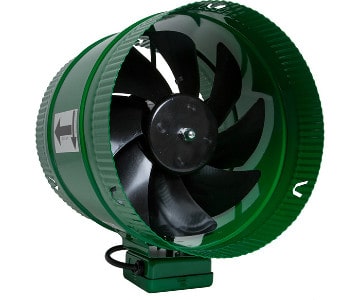
Booster fans work in conjunction with inline fans and ducting.
As you set up your primary ventilation system, each twist and turn of ducting decreases your inline fan’s overall CFM rating. Therefore, you can add booster fans into the ventilation system to reduce the CFM bottleneck.
Booster fans are ideal for:
- Boosting overall CFM of the existing ventilation system
- Pull air into grow room
- Push air out of the grow room
5. Blower Fans
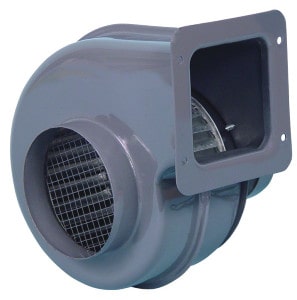
Blower fans, also known as squirrel cages or air movers, push a significant amount of air in very little time.
However, the immense power of blower fans comes at a price — noise. Unlike inline fans, blower fans are noisy and are not recommended for stealth growers or cannabis cultivators that need peace.
Blower fans are ideal for:
- Maximum air movement
- Direct air application
- Remove excess heat
6. Floor Fans
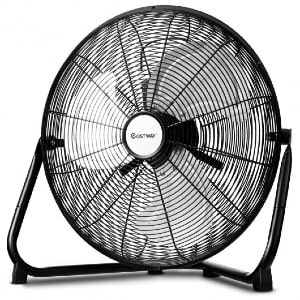
Last but not least are floor fans.
Floor fans are similar to clip-on fans and oscillating fans. However, floor fans are placed on the floor instead of wall-mounted in the grow tent.
Floor fans are ideal for:
- General air circulation
- Air movement through the underside of the plant canopy
Why Do I Need to "Duct" The Air?
Next, let's briefly talk about ducting.
Ducting is a system of pipes that channels air in a specific direction. Without proper ducting, your ventilation system must work twice as hard to remove air from the grow room.
Overall, ducting allows you to strategically vent air by:
- Connecting directly to inline and blower fans
- Connect directly to HID hoods
- Placed next to grow lights that do not have direct ducting ports
Furthermore, many brands offer insulated ducting that reduces noise and prevents heat from escaping during the ventilation process.
How Can I Control My Fan?
Fans have two settings: on and off — unless you buy a fan controller.
Fan controllers are devices that allow you to set a fan's speed to a desirable level. Depending on your budget, you can find various fan controllers that range from affordable to downright expensive.
Overall, the two most popular types of fan controllers among cannabis cultivators are:
- Fan-speed controllers
- Grow room controllers
Fan-speed controllers are the most basic device to control a fan's speed via manual knob settings. Alternatively, grow room controllers are all-in-one devices that control every aspect of the grow room's environment — including fan speed. Therefore, grow room controllers are top-of-the-line and inherently expensive.
Which Fan is Right For Me?
Now that you understand the basics of ventilation — which fan is right for you?
Well, it all depends on your grow room. Typically, ventilation systems are composed of multiple fans, such as inline, oscillating, and booster fans. However, the best starting point for beginners learning how to grow weed is to buy an inline fan and a basic fan-speed controller.
Here are a few other considerations when buying ventilation equipment for your grow room:
- Passive vs. active air intake
- The required amount of ducting
- Budget
- The total size of your grow room
- The total CFM needed to ventilate your grow room adequately
- The amount of heat your grow lights emit
Read More: The Best Grow Tent Fans for Marijuana Gardens
The Pros and Cons of Ventilation
Now that you understand the basics of ventilating your indoor cannabis grow room, here’s a summary of the pros and cons of ventilation.
The Pros and Cons of Mechanical Ventilation
- Predictable (controllable)
- Provides adequate ventilation
- Decreases humidity
- Reduces heat
- Prevents pest, disease, bacterial, and fungal outbreaks
- Enhances overall environmental conditions
- Affordable (depending on model, features, and brand)
- Expensive (depending on model, features, and brand)
- Requires technical knowledge
- Requires upkeep
- Noisey
Read More About Grow Tent Fans:
The Best Grow Tent Fans for Marijuana Gardens - Main Category Page
Finally, your cannabis garden is chugging along — lush green growth, sturdy branches, and flowers as far as the eye can see.
However, unbeknownst to you, a hidden predator lurks on the leaves, under the soil, or in the air. From one day to the next, all of your hard work can come crashing down because of a microscopic pest or disease.
Aside from a fire in the grow room, pests and disease are a grower's worst nightmare. Therefore, it's time to learn about pest and disease management products.
With the help of a few products, you'll learn how to prevent infestations before they begin. Since you're new to growing weed, this section is a must-read — your plant's lives depend on it.
Do I Need Pest and Disease Management Products?
We hear it all the time — do I need to buy pest and disease control products?
Even if you've never come across a single bug in the garden, the answer will always be the same — yes.
To give you an idea of what pest and disease control products deter, here's a list of common critters and diseases that decimate the gardens of unprepared cannabis cultivators:
- Spider mites
- Powdery mildew
- Anthracnose
- Leaf miner
- Aphids
- Fungus gnats
- Bud rot
- Root rot
- Thrips
- Whiteflies
- And many more
Each of these pests, fungi, bacteria, and diseases cause:
- Reduced yields
- Limited growth
- Discoloration
- Death
As you can see, nothing good comes from an infestation or outbreak. Therefore, a few handy pest and disease control products are essential for the indoor or outdoor garden’s health and safety.
Different Types of Pest and Disease Control Products
Now, let's look at the different types of pest and disease control products.
1. Insecticides and Pesticides
Insecticides and pesticides are necessary for pest management.
The moment you find a single pest, such as a spider mite, you must assume that there are many, many more.
Insecticides and pesticides come in two liquid forms:
- Concentrate
- Pre-mixed
As always, we recommend that you search for organic pesticides. Remember, you will eventually consume the buds from your cannabis plants. Therefore, you should only consider organic pesticides when choosing a pest management product.
2. Fungicides
Next in line are fungicides.
Fungicides prevent and control fungal outbreaks and their spores, which are typically systemic. Examples of fungal outbreaks are:
- Downy mildew
- Rusts
- Blight
- Fusarium
- Anthracnose
- Botrytis
Fungicides, similar to pesticides, come in two liquid forms:
- Concentrate
- Pre-mixed
Similar to pesticides, always choose an organic fungicide. Fungal infections are dire; however, you should never sacrifice your health or that of others with toxic fungicides.
3. Horticultural Oils
Horticultural oils, such as neem oil, are plant-based. Overall, horticultural oils play a dual role in insect and disease control.
Here's a list of effective horticultural oils that can be used for a wide range of pest and disease outbreaks:
- Neem oil
- Cottonseed oil
- Soybean oil
- Mineral oil
As with fungicides and pesticides, horticultural oils are offered as:
- Concentrate
- Pre-mixed
4. Insect Traps
Insect traps are the most basic form of pest control. However, they are effective, affordable, and straightforward to use.
Insect traps are typically cardboard or plastic cards that contain a sticky side. The sticky side is usually bright in color, such as fluorescent yellow, to attract pests.
You can hang insect traps throughout the garden, but remember, although they kill flying pests — they attract them as well.
5. Sulfur Burners
Last but not least is sulfur burners.
Sulfur burners are considered organic by agricultural regulators because they evaporate sulfur into the garden. As such, sulfur burners manipulate leaf pH to dissuade various pests and diseases from gaining a foothold.
A Word on Sprayers
Unless you buy a pre-mixed fungicide or insecticide, you must purchase a sprayer because you'll need to create your own mix with the concentrate.
Sprayers come in all shapes and sizes, and you should choose one that offers:
- Pinpoint accuracy
- Atomizing capabilities
- Easy to fill and use
- Long hose
- Adequate capacity
What is the Cost of Pest and Disease Management Products?
Overall, pest and disease control products are very affordable. Here's a list of products and their associated price tag:
- Pesticide concentrate: $40
- Fungicide concentrate: $20
- Neem oil (ready-to-use): $25
- Insect traps: $15
- Sulfur burner: $70
Remember, insect and disease management products should not be used often, but instead, a handful of times throughout the growing cycle. As such, each product should last multiple cannabis growing seasons.
Applying Pest and Disease Management Products
The golden rule when using a pest and disease control product is to follow the directions.
There's a long list of do's and don'ts, so make sure to pay attention when reading the instructions. Here are a few examples that you will likely find among pest and disease management products:
- Do not apply when windy
- Do not apply when hot or freezing
- Do not apply in direct sunlight
- Allow 4-8-hours before re-entering the garden
Although we recommend using organic pest and disease control products, there are rules that you must follow for the safety of your cannabis garden, yourself, and others.
The Best Pest and Disease Control Products For Beginners Growing Cannabis
Ultimately, pest and disease management is all about prevention.
Therefore, we recommend that you buy an easy-to-use pre-mixed bottle of neem oil and sticky traps. Not only are these two products effective, but they are affordable, too.
Other products, such as standalone pesticides, fungicides, and sulfur burners, should be reserved in the event of an outbreak. In terms of prevention, neem oil will safeguard your cannabis plants from most pests and diseases.
The Pros and Cons of Pest and Disease Control Products
Although there is an abundance of pros to using pest and disease management products, there are cons. Let's look at the pros and cons of pest and disease control products.
The Pros and Cons of Pest and Disease Control Products
- Affordable
- Easy to use
- Effective at preventing and controlling pest and disease outbreaks
- Improves plant health
- Maintains or increases the overall yield
- Reduces the beginner's overall stress level
- Many products are organic
- Inorganic products may pose health risks
- Inorganic products damage the environment
- May damage or destroy cannabis plants if applied incorrectly
Step 3: Buy Your Cannabis Seeds
Before discovering how to grow cannabis, you must learn how to order cannabis seeds in your country.
From understanding the cannabis laws in your country to placing an order, here are essential aspects to consider when ordering cannabis seeds online.
Legality
Before you decide to buy cannabis seeds, you must check your country's cannabis laws.
Are marijuana seeds legal? Can I grow cannabis seeds at home? These questions, and more, are essential in determining if you can order cannabis seeds in your country.
Stealth Shipping

Depending on the legality of cannabis seeds in your country, it's essential to find an online cannabis seed store that offers stealth shipping to your region.
There's nothing worse than a confiscated package — especially if your seeds were limited or one-of-a-kind. The best online cannabis seed stores offer ultra-stealth shipping, tracking codes, and, of course, a guaranteed reshipment if the first shipment fails.
If you want a stress-free experience while buying cannabis seeds in your country, stealth shipping offers nothing but peace-of-mind.
Payment Method
Once you have all of the cannabis seeds you could dream of in your shopping cart — it's time to check out.
However, not all online cannabis seed stores offer private or convenient payment methods. As such, it's best to avoid online cannabis seed stores that offer archaic payment methods, such as money orders or worse — cash in an envelope. Instead, search for an online cannabis seed store that provides several options to purchase cannabis seeds, such as Bitcoin, PayPal, or credit card.
Weather and Growing Conditions
![]()
Another fundamental aspect that you must consider is the climate and proper growing conditions for a particular cannabis strain.
Before you buy cannabis seeds, let alone grow marijuana, you must check if the strain’s growing conditions match that weather in your specific region. The last thing you want to do is order expensive cannabis seeds that cannot grow in your climate.
By ordering proper cannabis seeds for your region, you'll enjoy the lush greenery and massive buds all season long.
Learn How to Buy Cannabis Seeds Online In Your Country
To make your job easy, we’ve compiled comprehensive guides on purchasing cannabis seeds per country.
From stealth shipping, buying cannabis seeds with Bitcoin, and purchasing cannabis seeds in bulk, we cover everything from A-Z. If you're ready to buy cannabis seeds online, head over to our buy seeds category, where we answer all of your questions — one guide at a time.
How to Buy Cannabis Seeds in:
If you're ready to grow marijuana — it's time to pull the trigger and buy cannabis seeds from an online seed bank.
However, with countless online cannabis seed stores scattered across the world-wide-web, who can you trust? Let's head into the classroom of growing weed 101 to look at the essential elements when choosing a cannabis seed store.
Seed Quality
As you’ll learn, one of the basics of growing weed is buying high-quality cannabis seeds.
When it comes to seed quality, make sure you check an online cannabis seed store’s commitment to:
- Fresh cannabis seeds
- Viability tests
- Routine visual inspection
- Remove old seeds from seed stock
Pricing
The pricing of cannabis seeds is an essential topic that you must consider. Every cannabis cultivator has a budget, and it's up to you to determine how much money you'll allocate to cannabis seeds.
Here are a few weed grower's tips when it comes to buying weed seeds:
- Always buy high-quality seeds — even if it means fewer seeds
- Low-quality seeds produce cheap results
- Autoflowering and feminized strains are cost-effective
Available Strain and Seed Types
When searching for the best online cannabis seed store, always choose a shop that offers a diverse range of strains and seed types.
Here’s a list of what to look for in an online seed store:
- Indica, sativa, and hybrid strains
- Autoflowering and feminized seed types
Once confirmed that the seed bank of your choice has a wide offering, it’s up to you to decide which strain fits your garden
Discounts
We enjoy discounts like everybody else, so another essential growers' tip is to find a cannabis seed store that offers juicy deals.
Here’s a list of deals that you must keep an eye out for when browsing weed seed stores:
- BOGO (buy one, get one free)
- 50%-off sales
- Refer a friend discounts
- Veteran or senior discounts
- Daily deals
Who knows, you may find a once-in-a-lifetime offer on the best High Times cannabis seeds or massive savings from a bulk cannabis seed purchase.
Accepted Payment Methods
If you’re new to growing weed, you may not remember the dark ages of ordering cannabis seeds via cash-in-envelope or money orders. Luckily, we're past those days; however, not all cannabis seed stores offer convenient payment methods.
It's essential to choose an online cannabis seed bank that offers secure payment options, such as:
- PayPal
- Credit cards
- Debit cards
- wire transfer.
- Bitcoin
Choosing a seed store that offers convenient yet secure payment methods are essential for a stress-free experience.
Shipping
When choosing the best cannabis seed shop, you must consider multiple aspects related to shipping, such as:
- Does your choice ship to your specific region?
- Does your choice offer stealth shipping?
- Does your choice offer a re-shipment guarantee?
Remember, stealth shipping not only protects your investment but it also guarantees the delivery of your unique genetics. Once you receive your seeds — it's time to pull out the weed grow guide and begin your cannabis cultivation journey.
Reputation and Customer Service
When browsing marijuana seed shops online — which brand has the backing of the cannabis community?
Reputation and customer service are essential pieces of the puzzle if you want to grow high-quality weed. Here’s a list of how to determine the standing and customer service of a cannabis seed store:
- Read verified reviews
- Contact the seed shop directly with questions or concerns
When you buy weed seeds from a highly-rated seed shop, you’ll find:
- Authentic feminized or autoflowering seeds
- Fresh and viable seeds
- Helpful customer service
Learn About the Best Online Cannabis Seed Banks in One Place
It’s a big ask to single-handedly judge an online store’s commitment to overall seed quality, pricing, discounts, accepted payment methods, available strain types, shipping range and stealth methods, reputation, and, ultimately, customer service.
As an authority of all-things-cannabis, we offer dozens of in-depth reviews and rate each seed bank — so you don't have to.
Once you choose the best online cannabis seed store, you can focus on growing top-shelf weed at home.
With thousands of cannabis strains at your fingertips, finding the best cannabis strains to grow is both time-consuming and difficult. Additionally, picking the right strain is, hands down, the best way to grow marijuana at home or professionally.
Choosing the best cannabis strain is unanimously agreed as the most critical aspect of growing cannabis — so let's break out the growing weed for dummies book and look at everything you need to consider when choosing the right cannabis strain.
Indica, Sativa, or Hybrid?
First and foremost, you must narrow down a type of cannabis strain.
Whether you choose a tall-growing sativa or a bushy indica, your choice is heavily dependent on various aspects, such as:
- Personal preference
- Skill level
- The size of your cannabis garden
Once you narrow down the type, you're one step closer to growing marijuana at home.
Cannabinoid Content
Next, the vast majority of grow guides will point you towards your preferred cannabinoid content. Do you want a strain that exhibits sky-high levels of THC or a high concentration of CBD? Overall, the cannabinoid content can determine which strain you choose.
When choosing a cannabis strain based on cannabinoid content, consider these questions:
- Is the strain easy to grow?
- What is your personal tolerance to THC?
- Does the strain in question contain the right cannabinoid profile for your needs?
By answering these questions, you’ll be one step closer to choosing the best cannnabi strain.
Yield Potential
The yield potential of cannabis plants is the bread-and-butter of the majority of marijuana cultivators. Ask any grower, and they will tell you that one of the top goals of growing cannabis is to produce a massive yield.
Here is a list of questions to determine when choosing a cannabis strain based on yield potential:
- Does the strain yield better indoors or outdoors?
- What is yield difference between the feminized and autflowering version?
- Are the buds dense or fluffy?
- Can the branches take the weight or do you need to use support poles?
- Is the strain easy to grow?
- Does the strain offer high-quality bag appeal, terpene content, or suitable cannabinoid content?
Once you answer these questions, you can quickly decide if a high-yielding strain is right for you.
Terpene Profile
Choosing the best cannabis strain on the terpene profile is necessary because growing marijuana is a sensorial experience. As you smell, taste, and experience the effects of terpenes, you'll be glad that you chose to grow a cannabis strain that fits your preference.
However, not all cannabis strains are created equal. It's your job to transform yourself into a cannabis sommelier and decide which strain provides the most pleasing or pungent kick to the nose.
Here’s a list of primary terpenes that you will come across, and by understanding them, you will find a cannabis strain that suits your senses:
- Myrcene
- Caryophyllene
- Limonene
- Linalool
- Ocimene
- Bisabolol
- Pinene
Bag Appeal
Since it’s your first time growing weed — let’s talk about bag appeal. Bag appeal is how fire the final bud looks after harvest. Bag appeal is one of the most important aspects to consider before growing pot because everyone wants great looking weed.
Here’s a list of desirable traits that you want to find once your harvest your buds:
- High resin coverage
- Dense buds
- Loud aroma
- Pungent flavor
- Vibrant color
- Calyx formation
Value
Last but not least is the overall value of a cannabis strain. When it comes to the value of a specific cannabis variety, only you can decide if it's worth it or not.
Growing marijuana requires an abundance of time, effort, and money. Since each cannabis cultivator has different needs, growers value strains differently.
Therefore, you must choose a strain that holds value in your eyes. Remember, the price of the seeds does not give the strain intrinsic value. Instead, your opinion gives each cannabis variety its underlying value.
Ultimately, if you want to learn how to grow weed from seeds in the easiest way possible, always choose a valuable strain that you want to grow. By doing so, you'll enjoy the process of growing weed day in and day out.
Choose from The Best Cannabis Strains
As you can see, choosing the best cannabis strain is a challenging affair.
Luckily for you, we've compiled numerous lists that detail the best cannabis strains for select categories, such as the best High Times Cannabis Cup winners, the best high-yielding varieties, the best landrace strains, and so many more.
Each list presents the very best cannabis strains that the world has to offer, along with where to buy each strain in seed form. From THC percentages to growth traits, you'll find a wealth of informative content to help you narrow down your search while teaching you how to grow the best marijuana.
Not all cannabis strains are created equal, and each marijuana seed presents unique traits, such as grow difficulty, optimal climate, pest resistance, and growth characteristics. Although professional cultivators make everything look easy, growing marijuana isn't as straightforward as YouTube videos make it out to be.
By understanding everything there is to know about a specific strain — the better you can master the process of growing weed. Not only does this understanding give you a vital edge, but it will ensure a subsequent successful harvest of crystal-coated buds.
Whether it's your first time growing weed or you need to brush up on a few skills, allow this section of our grow guide to shine the light on the process of growing marijuana with the help of vital strain information.
Learn About the Strain's Background
Once you find an appealing cannabis strain, it's time to DYOR (do your own research).
When it comes to deciphering a strain’s background, it’s time to do some digging and answer:
- Who created the strain?
- What are the parent strains?
- Under what conditions was the strain bred?
- Is the strain intended for medicinal or recreational use?
Most of the time, the origin stories of cannabis strains are filled with mystery, luck, and countless hours of trial and error. However, understanding the strain’s background helps you put it into perspective.
A Strain's Difficulty Rating
Next, you must understand the difficulty rating of each cannabis strain.
Here are a few qualities that easy-to-grow genetics share if you want to grow weed stress-free.
- Stable
- Easy to feed
- Drought tolerant
- Predictable
- Ideal growth structure
- Resistant to pests and disease
Remember, always choose a cannabis strain that matches your skill level. As you can imagine, the difficulty rating of each strain will define your entire grow operation. In other words — choose wisely.
The Strain's Growth Traits
Another essential aspect to consider when growing cannabis is to look at a strain's notable growth traits.
Here are essential growth traits that you must understand:
- Does the strain grow tall or bushy?
- Does the strain prefer indoors or outdoors?
- Does the strain produce a pungent aroma?
- How long does the strain flower?
- Does the strain require support poles?
- Is the strain a heavy yielder?
- Is the strain vigorous or a slow grower?
Understanding the specific traits allows you to build your cannabis garden, such as space needed, required wattage, and nutrient preference. As you can imagine, all of these tidbits of information will make the process of growing cannabis as easy as pie.
Strain Appearance
Next, it's a good idea to know what the result will look like before you begin growing a particular cannabis strain.
We've seen it a million times before where cannabis cultivators choose a strain with a cool name, only to be disappointed by lackluster flowers with minimal bag appeal.
Instead, you must research what the cannabis variety of your choice looks like after harvest. Here’s a list of qualities that you should look for in a cannabis strain:
- Heavy resin production
- Flower density
- Calyx structure
- Color
Strain Properties
A strain's properties will make or break your experience. A strain's properties determine the overall potency, flavor, aroma, and medical effects.
If you want the best weed imaginable, make sure the strain you choose contains an abundance of:
- Cannabinoids
- Terpenes
Cannabinoids and terpenes are the backbone of the cannabis experience, and you'll be surprised by how game-changing a strain’s properties are when taken into consideration.
Skip the Research with The Help of a Cannabis Seed Index
If you're ready to learn everything about a particular marijuana strain, there's no better guide than our comprehensive Cannabis Seed Index.
Within the Cannabis Seed Index, you'll discover in-depth strain reports that cover:
- Origin
- Growth tips
- Essential characteristics
- Cannabinoid content
- Terpene concentration
- Where to buy feminized or autoflowering seeds
- Strain-specific effects and medical potential
- And much more
With the help of our Cannabis Seed Index, you'll know what to expect once you begin growing the cannabis strain of your choice.
Step 4: How to Grow Your Own Cannabis
How to Plan an Indoor Cannabis Garden
How to Plan an Outdoor Cannabis Garden
The Outdoor Grower’s Almanac
How to Create The Perfect Super Soil Mix For Unbeatable Buds
How to Properly Feed Your Plants
How to Foliar Feed Cannabis Plants
How to Use Liquid Nutrients For Cannabis Plants
How to Set The Perfect Height For Your Cannabis Grow Lights
How to Hang Cannabis Grow Lights
How to Set Up a Cannabis Grow Light Timer
A Fundamental Guide on Watering Cannabis Plants
How to Stop Under and Overwatering Cannabis Plants
How to Flush Cannabis Plants
The Encyclopedia of Cannabis Training Methods
How to Train Your Cannabis Plant With The LST Method
How to Lollipop Cannabis Plants
How to Super Crop Cannabis Plants
How to Top and FIM Marijuana Plants
How to ScrOG Marijuana Plants
How to SOG Cannabis Plants
How to Significantly Boost Cannabis Yields Indoors
How to Harvest Cannabis Flowers
How to Check Trichome Ripeness
How to Dry Marijuana Flowers
How to Trim Marijuana Flowers
How to Cure Weed
How to Store Weed



